
































































































































Trust in a passive fire protection manufacturer whose products and systems are underpinned by clear and accessible evidence of performance from rigorous testing. Collaborating in 250+ large-scale system tests and investing in its own fire testing capabilities.
As a practitioner of best practice, we go beyond testing, advocating independent certification even though it’s not always mandatory - but because it is the right thing to do.


Are you ready to Go Beyond?


























































Tyman International is a division of the Tyman group, a leading international supplier of engineered fenestration components and access solutions, listed on the London
The figures refer to the overall Tyman group for the year 2022.








Interpon
Interpon D1025
Specifications "Qualicoat Class
Interior
Residential
Recommended End Use

High-end residential buildings



































14


Impact of Efficient Façade Design on Building Energy Performance
Ar. Gagandeep Kapila, Director, Workshop for Metropolitan, Architecture
18 Sustainable Windows and Doors for Today and Tomorrow
Amir Hashmi, Chief Sales & Marketing Officer, Profine India Window
Technology Pvt Ltd
23 Climate Responsive Façade Designs for Better Energy Efficiency in Buildings
Ar. Janani Suresh & Ar. Goutham D. M., Architects, Mud Hands Architects, Bengaluru
28 Impact of Efficient Façade Design on Building Energy Performance
Mohammed Umar, M.Tech. Building Energy, Performance (2022-24), CEPT University, Ahmedabad
31 The Evolution of Modern Façades: Integrating Sustainable Design, Technology and Aesthetics
Pankaj Patel, Founder & Associate Director, Everest Façade System
36 Why is Water Penetration Testing So Important for a Façade?
P. Jothi Ramalingam Ponnusamy, Director, Winwall Technology
India Pvt Ltd
40 Deep Façades: The Transformational Power of Façades on Adaptive Reuse Projects
Gregory Kovacs, Design Director, Benoy
61 Industry Speaks
Interview with Sumit Gupta, Managing Director, Alstone
66 WFM AT 10 - A Decade of Knowledge Sharing
Messages from well-wishers
74 Cover Story
Façade & Fenestration Industry: Current State of the Market & Outlook for the Decade
102 Face to Face
Interview with Ar. Kiran Kapadia, Founder, Kapadia Associates
DISCLAIMER: With regret we wish to say that publishers cannot be held responsible or liable for error or omission contained in this publication. The opinions and views contained in this publication are not necessarily those of the publishers. Readers are advised to seek expert advice before acting on any information contained in this publication which are very generic in nature. The Magazine does not accept responsibility for the accuracy of claims made by advertisers. The ownership of trademarks is acknowledged. No part of this publication or any part of the contents thereof may be reproduced in any form or context without the permission of publishers in writing.
WRITE TO THE EDITOR Please address your suggestions to: The Editor, Window & Façade Magazine, C55, Okhla Industrial Area, Phase – 1, New Delhi, 110020 or email renu@wfmmedia.com. Please provide your full name and address, stating clearly if you do not wish us to print them. Alternatively log on to www.wfmmedia.com and air your views. The opinions expressed in this section are of particular individuals and are in no way a reflection of the publisher’s views.
“Printed and Published by Amit Malhotra on behalf of M/s F & F Media and Publications Printed and published at Thomson Press India Ltd, B-315., Name of the Editor-Ms. Renu Rajaram”

A decade ago, the spark of an idea ignited a journey to redefine an industry. Today, reflecting on a decade of thought leadership and industry evolution, we stand at the forefront of a multi-billiondollar façade and fenestration sphere.
Amidst India’s rapid transformation, our media house has stood resilient for 10 years, fostering trust and portraying the dynamic realities of this ever-expanding industry. From a city-centric perspective to the global stage, “WFMmedia.com” emerged, charting an incredible course since our Middle East startup in 2017.
As we step into the next decade, anticipate brilliance. We pledge a celebration of growth, a toast to India’s ascendancy, and a global narrative in facades, fenestration, business technologies, products, and services.
Join us in the celebration of our 10th edition, a testament to our unwavering commitment and global impact!
Stay connected on LinkedIn and other platforms for exciting updates, including the launch of our new carousel format platform.
Wishing you a stellar 2024 filled with success, where façades stand tall, but hearts remain pure.

amit.malhotra@wfmmedia.com
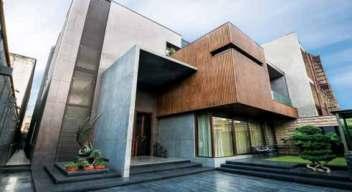
Efficient façade design stands as a crucial component in contemporary architectural methodologies, extending beyond superficial aesthetic considerations.Itsimpactgoesfarbeyond mere visual appeal, exerting substantial influence over a building’s holistic energy performance. This integral facet of architectural ingenuity plays a central role in mitigating energy consumption, bolstering sustainability efforts, and delineating the environmental footprint ofstructures.
In the context of this discourse, Architect Gagandeep Kapila, director of Workshop for Metropolitan Architecture, critically examines the

profound implications of façade design on building energy performance. This exploration aims to shed light on the multifaceted advantages it offers, emphasising its indispensable role in advancing sustainable construction paradigms. By delving

into the intricacies of façade design, this scrutiny not only highlights its functional and practical significance but also underscores its pivotal contribution to the overarching goal of creating environmentally conscious and energy-efficient structures.
Designing a façade efficiently involves purposeful integration of architectural elements, strategically crafted to elevate a building’s energy efficiency and adhere to environmental principles. The façade comprises essential components, including windows, insulation, shading devices, and ventilation systems, collectively assuming a significant role as the foremost defence against external influences. This ascribes paramount importance to the façade in the meticulous regulation of internal climate conditions within the building. By addressing these elements, efficient façadedesigncontributescruciallytothe overallperformanceandsustainabilityof the structure.

In the context of this discourse, Architect Gagandeep Kapila, director of Workshop for Metropolitan Architecture, critically examines the profound implications of façade design on building energy performance. This exploration aims to shedlightonthemultifacetedadvantages it offers, emphasising its indispensable roleinadvancingsustainableconstruction paradigms. By delving into the intricacies of façade design, this scrutiny not only highlights its functional and practical significance but also underscores its pivotal contribution to the overarching goal of creating environmentally consciousandenergy-efficientstructures.
A well-crafted façade serves as an exceptionally proficient thermal barrier, adeptly regulating the heat transfer between a building’s interior and exterior environments.Thestrategicincorporation of advanced insulation materials and cutting-edge glazing technologies is pivotal in mitigating heat loss during colder seasons while tempering heat accumulation in warmer climates. This strategic approach substantially diminishes the reliance on heating, ventilation, and air conditioning (HVAC) systems. Consequently, structures equipped with efficient façades realise noteworthy energy savings, resulting in a substantial decrease in operational costs andadiminishedcarbonfootprint.


The intricate interplay of these design elements accentuates the crucial role of an efficient façade in advancing energy efficiency and promoting environmental sustainability. Beyond its aesthetic appeal, the façade emerges as a linchpin in the pursuit of eco-friendly practices, showcasing its capacity to enhance energy performance, minimise environmental impact, and contribute significantlytotheoverarchingobjectives ofsustainableconstruction.
Attaining a subtle balance between the infiltration of natural light and the absorption of solar heat, a skillfully designedfaçadeaimstoenhancedaylight utilisation while concurrently addressing challenges like glare and excess heat. The incorporation of daylight-responsive lighting systems further reduces the reliance on artificial illumination during daylight hours, thereby effectively decreasing overall energy consumption. Thisflawlessfusionofnaturalandartificial lighting not only enhances the comfort and well-being of occupants within the built environment but also represents a conscientious effort towards achieving a harmoniousatmosphere.
The impeccable coordination of these design elements serves to emphasise not only the significance of adept façade design in optimising energy efficiency but also its paramount role in elevating the overall experience and satisfaction of individuals inhabiting the space. This thoughtful incorporation of lighting dynamics not only aligns with sustainability objectives but also
highlights a dedicated commitment to creating environments that prioritise both energy efficiency and occupant comfort. In essence, it underscores the crucial role of façade design in fostering spaces that are not only energy-efficient but also conducive to the well-being and contentmentofthosewithin.
The incorporation of passive ventilation strategies into façade design epitomises a judiciousmethodforenhancingindoorair quality. Extending beyond the reduction of reliance on mechanical ventilation, adequately ventilated spaces play a vital role in elevating occupant comfort levels and fostering heightened productivity. Moreover, the intentional incorporation of green façades and living walls introduces inherent air-purifying elements, thereby cultivatingahealthierandmoreconducive

built environment.This deliberate attention to passive ventilation techniques and the inclusion of green elements conveys a commitmenttocraftingspacesthatplacea premiumonbothoccupantwell-beingand environmentalsustainability.Theintentional implementationofthesestrategiesnotonly reflects a conscious approach to indoor air quality but also signifies a dedication to creating spaces that promote the holistic health and satisfaction of individuals within the built environment while aligning with principlesofsustainabledesign.
Strategicallydesignedandefficientfaçades provide an optimal framework for the effortlessemploymentofrenewableenergy technologies. Photovoltaic panels, solar thermal systems, and various sustainable energy solutions seamlessly blend with façadeelements,initiatingatransformative process wherein buildings transition into dynamic, energy-generating entities. This harmonious relationship between architecturaldesignandrenewableenergy sourcesextendsbeyondenergygeneration, serving as a catalyst for a substantial shift towards achieving zero-net-energy and carbon-neutral structures. The symbiotic fusion of architecture and renewable energy stands as a testament to a resolute commitment to sustainable practices and the advancement of environmentally consciousbuiltenvironments.
This intentional utilisation of renewable energy technologies within the façade not only contributes to the immediate generation of energy but also underscores a broader commitment to mitigating environmental impact. It exemplifies a forward-thinking approach to fostering buildings that actively contribute to the reduction of carbon emissions, aligning with the overarching objectives of sustainable development and environmental stewardship. The incorporation of these technologies into architectural design represents a pivotal step towards realising structures that not only meet the functional needs of occupants but also actively contribute to a more sustainable and ecologically responsiblebuiltenvironment.

In urban landscapes, the efficacy of façade design emerges as a central factor in mitigating the urban heat island effect. Through strategic measures such as sunlight reflection and reduced heat absorption, meticulously crafted façades actively contribute to regulating local temperatures. This proactive strategy effectively reduces the overall energy demand for cooling, reinforcing the resilience of cities against the impacts of climatechange.
Concurrently, the influence of efficient façade design on building energy performance transcends its visual appeal. A thoughtfully designed façade becomes a tangible manifestation of sustainable architectural principles, propelling the realisation of energy-efficient, resilient, and environmentally conscious urban environments. As the momentum for sustainable construction practices intensifies, architects and designers are compelled to consistently prioritise and refine efficient façade design. This dedicationheraldsaneracharacterisedby structuresthatnotonlycatertotheneeds of occupants but also align with broader planetary considerations, marking a substantial stride towards a sustainable and harmonious coexistence with the environment. The integration of these principles underscores the profound impactthatthoughtfulfaçadedesigncan have,notonlyonindividualbuildingsbut onthebroaderurbanfabricanditsability to address contemporary environmental challenges.

Ar. Gagandeep Kapila, an inherently talented architect, discovered her passion for the delicate balance between creativity and technicality, leading her to pursue a career in architecture. After graduating from the TVB School of Habitat Studies, she co-founded the Workshop for Metropolitan Architecture (WMA) in New Delhi, dedicated to design excellence. Embracing a minimalist ethos, WMA, under her guidance, specialises in high-end, designoriented projects. Gagandeep’s designs exude elegance, emphasising seamless materiality and a fusion of contextual cueswithsustainability.Withadecadelong legacy, WMA’s multidisciplinary approach has garnered recognition in prestigious publications. Gagandeep’s architectural finesse extends to diverse projects, from residences to retail spaces, earning her accolades and speaker invitations at industry events. Her commitment to timeless design setsWMA as a trailblazer in the architectureanddesignarena.


Sustainability is the most talked about term these days for every aspect of development across varioussectorsweseeandaimtoachieve in the future. In the past 100 years, humans have done wonders in the field of innovation by contributing to making our lives advanced and easy. However, this growth and innovation have come at the cost of the rapid depletion of natural resources with adverse effects on the environment.Asaresult,theenvironment has become highly polluted thereby affecting health and having detrimental future consequences as well. So, what is important, merely the development of products which make our life easy at the cost of environmental damage or products which uplift our lifestyle by not harmingtheenvironment.
In recent years, people have become more conscious about their role towards conserving the environment for current and future generations. They have started realizing if they don’t take a step today, it will be hard to repair the environmental damages caused by irresponsible choices. Therefore, it is our collective responsibility
to be more aggressive towards adopting a lifestyle in harmony with nature, where sustainable products become the new trend.Thesesustainableproductsmaylook premium or exclusive, but the long-term advantages outweigh the cost. That’s the onlyway,wecanachieveourenvironmental goalsfortodayandtomorrow.
With the growing demand for infrastructure development, technology has a major role in inventing sustainable
products or improving existing products that align with environmental objectives. uPVC is one of the popular sustainable materials amongst other building materials used in manufacturing doors and windows. uPVC is 100% recyclable and naturally sustainable, it can be recycled several times without losing its physical performance properties like, strength, surface finish and resistance to adverse weather conditions, and remains intactforitslongservicelife.



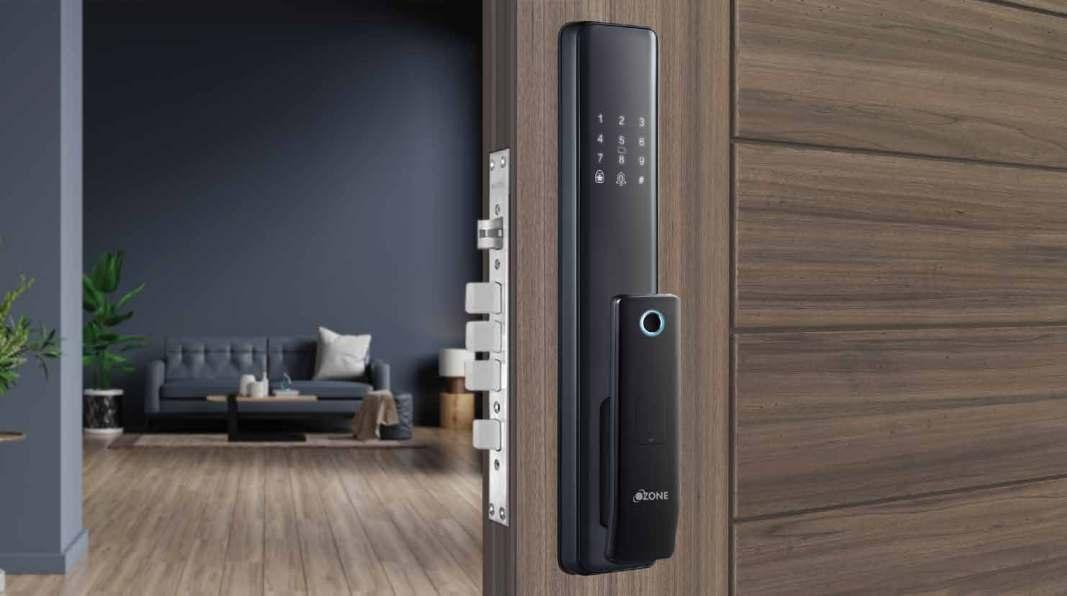



uPVC windows and doors are an excellent way to make your home more energy-efficient while reducing carbon footprints. With the modern world becoming more environmentally conscious, sustainable windows and doorshavebecomeincreasinglypopular. These windows and doors are designed to be energy-efficient, weather-resistant, and durable, making them an excellent choice for homeowners.
One of the notable benefits of uPVC windows and doors is their ability to conserve energy. These windows and doors are developed by using materials that are designed to prevent heat loss, whichmeanstheyensurethatyourhomes will stay warmer in the winter and cooler in the summer. This, in turn, reduces the amountofenergyrequiredtoheatorcool your homes, which can lead to significant savingsonyourenergybills.
Another advantage of uPVC windows and doors is their durability since they are designed to withstand harsh weather conditions, such as strong winds, heavy rains and extreme temperatures. This means that you won’t have to repair/ replace them as often as traditional windows and doors, which can save you moneyinthelongrun.
One of the most exciting developments in uPVC windows and doors is the use of special glass options available in the market. These types of glasses control the amount of light and heat that enters
a building and help to reduce energy consumption by minimizing the need for heating and cooling systems. These glasses can also help to improve the comfort of buildings by reducing glare and eliminating the need for window treatments.
Another promising development is the use of recycled materials in the production of windows and doors. This can help to reduce the environmental impact of manufacturing while also creating products that are more affordable and sustainable. Additionally, new manufacturing techniques are being developed that use less energy and producelesswaste.
The future of these sustainable uPVC windowsanddoorslookspromising.With the growing awareness of the benefits of these products among the masses, demand will continue to increase further. This will drive further innovation and investmentinresearchanddevelopment, leading to new and enhanced products that are more sustainable and environmentallyfriendly.
In conclusion, investing in sustainable uPVC windows and doors is not only a smart financial decision but also an environmentally responsible one. By reducing your energy consumption and choosing eco-friendly materials, you can make a positive impact on the planet and enjoy more comfortable and durable livingspaces.

Chief Sales & Marketing Officer, Profine India Window Technology Pvt Ltd
Amir Hashmi is a mechanical engineer with a poised professional career of three decades in the field of sales and marketing, serving the public and private sectors. He has been successful in creating a market for Koemmerling uPVC window and door systems which was new to the fenestration industry a decade ago. His expertise has played an instrumental role in establishing uPVC as a product for the future and gainingtrustintheIndianmarketand has an impactful contribution to the brand value. Earlier during his public sector tenure, he was constructive and successful in promoting MSME sector in the Indian and international markets and establishing their footprints to flourish.


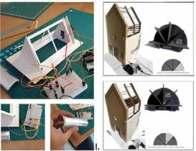
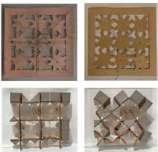
The façade plays an important role in a building as it is the primary interface between the interior and exterior. The façade therefore becomes the crucial element that manages entry for light, heat, sound, dust and a view to the world outside. Additionally, it sets the tone and theme for the design as it is a visual statement for the entire building, likeacoverwrappingthebook.Especially in the case of public buildings where people enter into an unknown context, the façade can play a role architecturally to invite or ward away, to tower above or to stay grounded, to look rigid or feel playfulandthelike.
From the point of view of sustainability, façade and roof design are of paramount importance in cutting down energy needs. The approach to façade design can be vernacular, that is, using locally available materials and construction technology. This generally tends to be energy-conservative, resource-efficient and able to boost the local economy. However, the contemporary world may demandadifferentaestheticthatcansuit themoderncontextandlifestyle.Asoffice spaces and commercial outlets look for largerglazedfaçades,oneencountersthe
problemassociatedwithexcessheatgain in tropical latitudes. The perfect balance of optimal lighting levels to minimal heat gainissoughtout.
Architects perform climatic studies to arrive at the correct orientation of the building in the given region and context. Further,onemustassesstheavailabilityof views outside, visibility to the skyline and the character of the light to be admitted inside the space. It is well documented that the availability of natural light and ventilation,andtheaccesstoviewsofthe outside have a positive influence on the occupant’s well-being and productivity. The percentage of window-to-wall can also be analysed using energy modelling applications to arrive at an informed decision. Such models allow architects to compare the proposed design with a base case scenario averaged out for annualperformance.
Advances in technology and analysis tools have led to a shift in façade making. Performative façades that respond to the real-time external or internal environments are effective in modulating design.Forinstance,thefaçadeapertures mayopenandclose,muchlikethepupils
of the eye based on sensing the intensity of light. The awning systems may retract orprotractbasedontheamountofdirect lightonewantstoadmitinsideandthese may be set to correspond with the sun angle. Such a dynamic façade speaks directly to the natural elements and can provide optimal lighting and heating conditions for the interior space. The dynamic façade system can be achieved through programmed microcontrollers that operate the elements. Alternatively, one can employ specialised materials thataresensitivetotemperaturechanges and exhibit the shape memory effect. A façade made using shape memory alloys can transform without the use of an energy source but uses the sun’s heat as the stimulus for response. Such an alloy has the property of remembering the initial shape provided to the material and exhibits the property of returning to the initialformasaresponsetotemperature.
Lighting and maintaining thermal comfortarethetwofunctionsthatuseup nearly85percentofthebuilding’senergy needs.Here,thefaçadedesignedtoallow sufficientnaturallightandventilationplay aprominentroleingreenbuildingdesign. The use of operable windows ensures air movement and reduces the need for air conditioning. Designers can play with fenestration size and orientation to alter windvelocities.
The façade is akin to the skin. Based on the climatic requirements, the façade should be able to shield the interiors from heat, cold and precipitation. A good skin can also preserve the interior heat in a cold climate or keep the interiors cool in hot and dry external conditions. To achieve thermal comfort in an extreme climatic zone, higher thermal mass can be opted to reduce heat transfer through conduction.Theuseofasecondskinwall works as a shading element to cut off harshanddirectsunlight.
JP Nagar, Bengaluru

Located on a medium-intensity vehicular traffic main road in central JP Nagar, Sun Chime is a multi-storey commercial and residential complex, nested amongst other commercial establishments and places of worship surrounding it. The project faces the South side of the main
road 60 feet wide and receives ample sunlight on its south façade. As the buildinghouses6000Sqftofcommercial space, the façade was designed to draw people’s attention as an interesting and invitingspace.
The façade is composed of glass, solid concrete masonry and a clay block latticework or jali. The walls and fenestrations in the residence levels are sheltered behind the jali work. Such a secondary skin shields the interiors from direct sunlight. While cutting out heat,
it is able to bring light to the interiors, creatingadynamicplayofpatternsonthe floor.Astheairpassesthroughthesmaller apertures of the jali wall, it moves with a highervelocityduetotheBernoulli-Venturi effect. The air velocity for a given volume of air increases through a smaller crosssectionareaofopeningsize.Anincreasein air velocity causes a drop in pressure and has a cooling effect on the interior space. Apartfromtemperatureandwindvelocity regulation,thejaliwallfunctionstoprovide visual privacy, yet allowing natural light basedonaperturesize.





The façade detail combines a contemporary design juxtaposed with concepts from traditional architecture resulting in a unique new identity. The


hollow clay blocks are stacked between steel rods fitted onto a metal frame. The latticeworkofthefaçadehasaperforation percentage of 19 %. Climatic data was
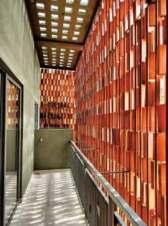
collected between 12:30 to 1:30 pm on a sunny winter noon in the month of December. The average temperature difference between the exterior(A) and a point(B) on the interior space 3 feet away from the façade was noted to be 16.8 degrees Celsius. The daylight factor was found to be 1.9. The interior was found to be in the thermal comfort zone even though external conditions were hot and dry.Theresearcherswereabletoperceive low-velocity air movement passing throughthejaliintotheindoorspace.



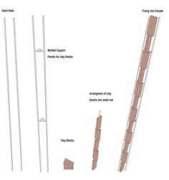
It must be noted that the study has limitations of being unable to isolate the effect of Jali work alone and the thermalconditionsintheinteriorsarealso influenced by other factors such as the roofing and thermal protection provided bytheupper-levelbuiltmass.


• Project: SunChime-Amixeduseproject
• Location: JPNagar2nd Phase, Bangalore
• Client: TheKindRoastery&Brew room,privateresidences
• Architect: MudHandsarchitects
• OtherConsultants: Opera HomesDevelopers
• Materialsusedforfaçade& fenestration: ClayBlocks,Steel andconcretemasonry
• CommencementDate&
CompletionDate: January 2020-January2022

AR. JANANI SURESH Architect & Co-Founder, Mud Hands Architects, Bengaluru

AR. GOUTHAM D. M. Founder & Principal Architect, Mud Hands Architects, Bengaluru
Janani Suresh is an architect & independent researcher. She is passionate about sustainable architectural systems having studied Sustainable architecture from NPTELIIT Roorkee. Through her professional career of eight years in the industry of architecture, she has worked on various research projects onalternativedesignandinclusiveurbanism.
Ar. Goutham is the founder and principal architect at Mud Hands Architects, Bengaluru. As an architect, civil engineer and archipreneur, he has worked in integrating alternative building technology and design into the urban context. He specializes in employing technological interventions to improve the efficiency of building systems. He has mentored many students through teaching, internships, and knowledgesharingworkshopsacrossthecountry.

Building operation accounts for 30% of global energy consumption and 26% of global energy-related emissions according to BuildingsEnergy Systems - IEA (n.d.). Commercial and residential buildings consume about 33% of the energy for cooling and daylighting in India (Kumar et al., 2017). Due to such significant contributions to negative phenomena like increasing carbon emissions, rising global temperatures, and climate change, optimisingbuildingenergyperformance has become a matter of utmost importance as a corrective measure. In fine-tuning a building’s energy use, looking at customised climateresponsive design solutions that reduce building energy demand, also called passive design, becomes crucial. Passive design is as important, sometimes more, as deploying efficiently-performing airconditioning and ventilation systems. Passive design involves parametric analysis considering the element-wise contribution to the building heating/ cooling demands. The critical aspect of passive design is the building envelope thatseparatesthebuilding’sconditioned and unconditioned environment.
Building performance simulations (BPS) reveal that the envelope, comprising the
building façade and the roof, contributes 50% to the cooling demand for a college building in Kolkata, India. A lower cooling demand implies a lower HVAC system sizingandenergyconsumption.Thus,the building must have an energy-efficient façade, as its significance is high on the building’s energy performance and occupant thermal comfort. (As shown in Figure1).
Various parameters must be addressed for a façade design to be considered energy-efficient. As all buildings are different, these parameters need tweaking based on the climate zone, construction type, and space conditioning needs. Factors, along with their impacts, that are taken into consideration while designing afaçadeare:
• Thermal Insulation: The thermal insulation of a façade directly translates to the reduction in heat transfer in the building. A higher insulation provides more delay in the rate of conductive heat gains for the building. This results in lower energy consumption for maintaining a thermally comfortable environment. The thermal insulation performance of a material, wall, or window assembly is expressed in terms of its thermal resistance, or R-value. The mathematical inverse of the R-value is the U-value, or the thermal transmittance, another commonly used metric to understand the heat transfer rate. (Figure2showsthebreak-upofthe façade heat gains/cooling demand in Figure 1).



• Window Glass Optimisation and Daylighting: Unlike walls, it is not enough to only thermally insulate the windows to expect a reduction in heat transfer, as windows also bring in heat via radiationandnotonlyconduction. The window-to-wall ratio (WWR) should be well thought out, and the window glass needs to be optimised in terms of its solar heat gain coefficient (SHGC) and visible light transmittance (VLT) values to ensure that daylight ingress is adequate while the radiative heat gain component is low. Modern products such as low-e coating glass and high-performance glazing offer optimised glass for energy-efficient buildings.
• Shading Control: Incorporating shading control devices such as horizontal cantilever shades and sidefins adjacent to the windows assists significantly in cutting down the direct component of daylight through the windows. Shading devices thus reduce the radiative heat gains, which is the most significant contributor to the building cooling demand. The importance of shading devices is depicted in Figure 3, which shows an average 36% reduction in radiative heat gains by adding a horizontal shading device on the south façade. Products such as automated blinds and shades
can further help in reducing glare hotspots and visual discomfort.
• Thermal Mass: The presence of materials with high thermal mass in the building façade helps offset heat gains as the thermal mass stores the heat equivalent to its heat capacity. This stored heat creates a thermal lag, serving as a natural temperature buffer, reducing the building’s reliance on mechanical cooling systems and contributing to improved energy efficiency and occupantcomfort.
• Material Selection and SRI: The materials used in the façade, such as claddings and paints, have a significant impact on the energy performance of the building. Reflective materials and lowemissivity coatings can minimise heat absorption and heat transfer, respectively, by direct radiation. The reflectivity of a surface can be determined by its solar reflectance index(SRI).Thepracticeofemploying high-SRI white paint on rooftops, commonly referred to as cool roofs, is on the rise due to its low-cost and highly effective approach for mitigating heat gain through the roof surface, which accounts for 58% of the conductive heat gains for the buildinginFigure2.
• Airtightness: A well-designed façade should ensure airtightness
to prevent air leakage. Air leaks can lead to energy wastage, as heating orcoolingsystemsmustworkharder to maintain a consistent indoor temperature.
• Natural/Mixed Mode Ventilation: Façade design should incorporate elements that facilitate natural or mixed mode ventilation. Well-placed windows, louvers, or vents can promote the circulation of fresh air, reducing the reliance on mechanical ventilation systems, and at times when the ambient conditions are favourable, can reduce the reliance on air-conditioning systems as well. This not only saves energy but also enhances indoor air quality. The automated control of windows is necessary for efficient window operation, and it can be achieved through smart window actuators, remotecontrolsystems,andCO2 and airqualitysensors.


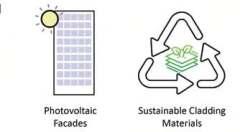
• Renewable Energy Integration: With the advent of glass with integrated solar cells, known as photovoltaic glass, façades can now integrate renewable energy for enhanced energy efficiency and reducedcarbonemissions.
Technological innovation in façade design has resulted in products that aid building energy performance. Prominent examplesofsuchproductsarelistedhere.
• Electrochromic glass: Electrochromic glass, commonly called smart glass, can change its transparency or opacity in response to electricity. It hasapolymerdispersedliquidcrystal (PDLC)filling,inwhichtheliquidcrystals align when electricity is applied and make the glass clear or transparent, and get scattered when power is turned off and render the glass as opaqueortranslucent.
• Dynamic shading systems: Dynamic shading systems comprise automatic motorised blinds, shades, and louvers that automatically adjust their positions based on
programmed schedules or changing lightingandtemperature.
• Photovoltaicfaçades: PVintegrated façades consist of solar panels or cladding materials incorporated into the glazing. This reduces energy costs and contributes to renewable energy generation and carbon emission reduction. These systems are also called Building Integrated Photovoltaic(BIPV)systems.
• Sustainable cladding materials: Looking at the entire lifecycle of a materialaspartofthewholebuilding designapproach,bio-basedmaterials are being incorporated in façade claddings to minimise environmental impact.
Buildings-EnergySystem-IEA.(n.d.).Retrieved October 18, 2023, from https://www.iea.org/ energy-system/buildings#programmes
Kumar, G. K., Saboor, S., & Babu, T. P. A. (2017). Study of Various Glass Window and Building Wall Materials in Different ClimaticZonesofIndiaforEnergyEfficient Building Construction. Energy Procedia, 138(December),580–585.

MOHAMMED UMAR
M.Tech. Building Energy Performance (2022-24) CEPT University, Ahmedabad
Mohammed Umar is a postgraduate student of the M.Tech. Building Energy Performance program at CEPT University.Beingapassionatebuilding energy professional, Umar is an architectwithtwoyearsofexperience, having worked on regional and international BIM projects. The areas ofworkincludewholebuildingdesign (building energy-use optimisation through passive and active interventions), financial feasibility of energy conservation measures, data analysis, thermal comfort analysis, and optimisation of HVAC systems. Togetherwithateamof3batchmates, he is the recipient of the prestigious Student Building Simulation Award at the 18th International IBPSA Building Simulation Conference 2023, held in Shanghai, China. Currently working on the analysis of large energyuse datasets of net-zero buildings, Umar’s goal is to engage in projects that assist in the implementation of Environmental,SocialandGovernance objectives.

In today’s fast-paced & environmentally conscious world, the concept of modern façade design has transcended its traditional role. Modern façades are no longer just about the external appearance of a building; they have evolved into dynamic systems that integratesustainability,energyefficiency, safety, & aesthetic appeal. Meeting the demands of sustainable construction, heatingresscontrol,energyconservation, safety,cost-effectiveness,ventilation,and daylighting, contemporary façades are pushing the boundaries of innovation and reshaping the architectural landscape.
At the heart of modern façade design lies the imperative to embrace sustainability.
With a growing awareness of climate change and the need for energy-efficient buildings, modern façades are designed witheco-friendlymaterialsandinnovative technologies.Architectsanddesignersare now increasingly turning to sustainable materials such as recycled steel, lowemissivity glass, and photovoltaic panels that harness solar energy, contributing to reduced carbon footprints and enhanced energyefficiency.
The battle against heat ingress is a critical aspect of modern façade design. To combat rising temperatures and reduce the reliance on mechanical cooling, architects are integrating high-performance glazing, thermal insulation, and shading systems into
their designs. Dynamic shading devices such as adjustable louvers and automated blinds are becoming popular choices, effectively regulating the amount of sunlight and heat entering the building. Additionally, the incorporation of innovative insulation materials and the strategic orientation of the façade are key strategies employed to ensure energy conservation and optimal thermal comfort within the building.
Modernfaçadesprioritizethesafetyand durability of the structure. Advanced fire-resistant materials and state-of-theart fire safety systems are integrated into the façade design, ensuring the protection of the occupants and the structural integrity of the building. From fire-resistant cladding materials to advanced smoke control systems, every aspect of the façade is meticulously engineered to meet stringent safety standards, providing occupants with a secureandreliableenvironment.
While the focus on sustainability remains paramount, modern façade design also emphasises cost-effective solutions that deliver long-term value. Architects and developers are exploring innovative yet economical materials and technologies that offer durability and energy efficiency at an affordable cost. The integration of durable, low-maintenance materials and the adoption of energy-efficient systems not only reduce operational expenses but also enhance the overall lifespan of the façade, making it a prudent investment for the future.
Modern façades are designed with a keen emphasis on promoting natural ventilation and maximizing daylight penetration. The strategic placement of
operablewindows,ventilatedfaçades,and breathablematerialsfacilitatesaconstant flow of fresh air, promoting a healthier indoor environment and reducing the reliance on mechanical ventilation systems. Moreover, the incorporation

The Bank of India Zonal Office at Andheri West, crafted meticulously by the skilled team at Everest Façade System, exemplifies the integration of innovative sustainable design elements into its façade and fenestrationsolutions.
The careful selection of materials, the strategic implementation of innovative technologies, and a comprehensive focus
on sustainability have collectively resulted in a structure that not only minimizes its environmental impact but also serves as a model for cost-effective and efficient architecturalsolutions
While prioritizing sustainability and innovation, the team also ensured that the project remained cost-effective without compromising on quality or performance.
of high-performance glazing and lightdiffusing materials allows for the optimal utilization of natural light, creating a bright and inviting interior space while minimizing the need for artificial lighting duringdaylighthours.
By carefully selecting materials and technologiesthatofferlong-termdurability, energyandefficiency.
To ensure optimal energy conservation, the design team implemented a meticulously curated combination of elements, including a unitised structural glazing system, openable vents, and smoke seals. These elements were specifically chosen to minimize heat ingress and promote natural ventilation, thereby reducing the building’s reliance onmechanicalcoolingsystems.

The integration of spandrel panels, strategically placed 50mm away from the glass surface ensures a significant reduction in heat transfer

The integration of spandrel panels, strategically placed 50mm away from the glass surface along with insulation, ensures a significant reduction in heat transfer, thereby enhancing the building’s thermal performance. Additionally, the incorporation of calcium silicate boards, boasting a non-combustible nature and a two-hour fire rating, serves as a secure seal between the RCC structure and the structural glazing, ensuring both safety andlongevity.
The integration of spandrel panels, strategically placed 50mm away from the glass surface along with insulation, ensures a significant reduction in heat transfer, thereby enhancing the building’s thermal performance. Additionally, the incorporation of calcium silicate boards, boasting a non-combustible nature and a two-hour fire rating, serves as a secure seal between the RCC structure and the structuralglazing,ensuringbothsafetyand longevity.
The Bank of India Zonal Office at Andheri West is a testament to the tangible benefits associated with the integration

PANKAJ PATEL
Founder & Associate Director, Everest Façade System
of sustainable design. This project serves as a testament to the crucial role that sustainable design plays in shaping the future of the architectural landscape, serving as an inspiration for the industry to embrace environmentally conscious practices and create a more sustainable built environment for generations to come.
• Project: BOI(ZonalOffice)
• Location: AndheriWest, Mumbai
• Client: GDProjects
• Architect: Ar.ShashiPrabhu
• OtherConsultants: Uday MasterandAssociates
• Materialsusedforfaçade& fenestration: Unitisedglazing System,DGUGlasswithST series,FireratedACP,Aluminium Fins
• CommencementDate& CompletionDate: November 2019toOctober2020
With an illustrious 19-year track record in the façade design and fabrication industry, founder and associate director of Everest Façade System, Pankaj Patel has established a formidable reputation for pioneering excellence and innovation. His visionary leadership has steered the companytowardsremarkableheights, consistently delivering cutting-edge solutionsandsettingnewbenchmarks in architectural design. Armed with a profound understanding of materials, technologiesandmarkettrends,Patel’s strategic insights have propelled the organization to the forefront of the industry. He has an unwavering commitment to precision and quality, which has cemented the company’s position as a trailblazer, redefining the boundaries of contemporary façade designandfabrication.



High-rise buildings, towering marvels of modern architecture, stand as symbols of human ingenuity and progress. However, beyond their awe-inspiring aesthetics and innovative designs, there’s a very serious risk that can give nightmares to the occupants — water infiltration from the façade. Water penetration, if left unchecked, can cause structural damage, cause serious damage to the electrical, data cabling and furnishing which could lead to costly repairs.
Before delving into the specifics of these tests, it’s crucial to understand why they are essential. Water intrusion in highrise building façades, windows, doors, and skylights can lead to a cascade of problems, including:
• Structural damage: Water seeping into a building’s structure can weaken it over time, compromising its integrity and safety.
• Electrical short circuit: Poorly sealed opening can lead to water seepage falling on electrical and data circuits crisscrossing within the building leading to a serious safety risk.
• Aesthetic deterioration: Water stains can damage a building’s appearance, diminishing its value and appeal.
Given these consequences, it’s evident that testing for water penetration is more than just a formality — it’s a necessity for ensuring the longevity, functionality, and aesthetics of high-rise buildings.
There are two steps in testing which are critical to ensure a watertight façade.
1. Offsite water infiltration testing as a part of the PMU test conducted at the testing laboratory before the mockup sample is approved for installation.
2. Field water testing which is conducted at the site during the installation of the façade system on a progressive basis to ensure consistency in the fabrication and installation process.
ASTM E 331 is a standard test method conductedatthetestinglaboratoryas a part of the PMU test to evaluate the water resistance of exterior windows,

• Mold and mildew: Damp interiors canfostermoldandmildewgrowth, which not only poses health risks but also causes unsightly and costly damage. Water penetration, if left unchecked, can cause structural damage, cause serious damage

curtain walls, skylights, and other similar building components. This test is often referred to as the “Static Water PenetrationTest”.
The purpose of ASTM E 331 is to assess how well these building components can withstand water infiltration when subjected to a uniform differential static water pressure. The test is typically conducted in a laboratory setting to ensure that the components are waterresistant under specific conditions. It’s important to note that this test is just one part of a comprehensive evaluation of a building’s resistance to water penetration.
Here’sabriefoverviewofthekeyaspects of ASTM E 331:
What theTest Evaluates: ASTME331primarilyevaluatesthewater tightness of windows, curtain walls, and similar elements when they are exposed to a controlled, uniform water spray.The testhelpsdeterminewhetherthesystem designed for the project can prevent water from penetrating into the interior
of a building even when a specified differential negative pressure is applied.
Coupled with the ASTM E 331 is the AAMA 501.1 test, developed by the American Architectural Manufacturers Association (AAMA), assesses a building’s resistance to water penetration under cyclonic conditions. This means it evaluates how well windows, doors, and curtain walls can withstand wind-driven rain, simulating real-life conditions.
Building Envelope Integrity: The test helps ensure that the building envelope, including its fenestration systems, can withstand heavy rain and also effectively check if external features like bull nose, horizontal trellis work, second skin panelsetc.donotvibrateorrattleduring cyclonic wind storms.
Durability: Byidentifyingpotentialweak points, the test helps prevent long-term structural damage and maintain the building’s appearance.
The AAMA 501.1 test involves subjecting the mockup sample’s exterior to positive water pressures while monitoring for any water ingress using a large fan or a propeller engine. It’s a comprehensive processthatincludes:
Observation: Trained technicians and the consultant and client’s representatives monitor the presence of water leaks inside the testing chamberduringthetestanddocument the same using observations and photographs.

Field water testing is conducted at the site during the installation of the façade system on a progressive basis

Once the PMU test is successfully completed at the testing laboratory theconsultantsignsoffforinstallation ofthefaçadepanelsatthesite.
Thekeystandardsthathelpusunderstand theconsistencyinthequalityoffabrication and workmanship of façade panels being installed at the site are AAMA 501.2 or ASTME1105
Here’s why AAMA 501.2 and ASTM E 1105 aregamechangersintheindustry:
Conditions: AAMA 501.2 and ASTM E 1105 are all about bringing laboratory precision to the field. By subjecting installed windows, doors, curtain walls, and skylights to uniform or cyclic static air pressure differences, it simulates real-world conditions, ensuring that our buildings stand strong against the elements.
Water Infiltration Prevention: Water intrusioncanleadtosignificantstructural damage and indoor environmental issues. This test method evaluates the ability of exterior building components to resist water ingress, ensuring that the elements stay outside where they belong.
Assurance: Performing AAMA 501-2orASTME-1105,youknowthatthe buildingfaçadehasbeencomprehensively tested during the entire process of installation, at random locations and the riskofwaterleakshappeningthroughthe façade is almost negligible. It’s a mark of qualityandreliability,whichisessentialin theconstructionindustry.
Whether you’re a homeowner or a commercial property developer, knowing that your doors and windows meet these high standards provides peace of mind. It’s an investmentinthelong-termperformance anddurabilityofyourbuilding.
Let’s remember that the building envelopeisthefirstlineofdefenceagainst the elements. By conducting water penetration tests done at an accredited third-partylabandatthesitewillhelpthe occupants enjoy a façade without water leaks
With a rich history spanning over 10 years, Winwall Technology India Pvt Ltd has firmly established itself as a trusted agency in the testing industry. Having successfully completed 450+ projects, our extensive experience has garnered credibilityandreliabilityinthefaçadeand fenestrationindustry.

P. Jothi Ramalingam Ponnusamy is the Director of Winwall Technology India Pvt Ltd, an ISO 17025 and an NABL performance testing laboratory. He has been associated with the architectural aluminium industry since 1990 as an anodising and powder coating specialist. He is presently a member oftheDoors,Windows,andShuttersSectional Committee, CED 11, which is responsible for creating the Indian Standards for the design, fabrication, testing and installation of doors, windows, and shutters. Jothi Ramalingam has constantly strived to create more test facilities in India for the benefit of the Indian façade and fenestration industry thereby helping the industry to improve its quality and successfully compete internationally. Under his stewardship, Winwall India has been accredited by NABL as the first laboratory in India for NFPA 285 testing of the fire propagation characteristics of exterior wall assemblies containing combustible components, testing facility for processed glass and conducting cyclic testing of hardware used in the window and door industry.JothiRamalingamisnowinvolvedin commissioninganewresistanceandreaction tofiretestinglaboratorytotestproductsused intheconstructionindustryforitsfire-resistant properties thus contributing to making high rise buildings safer from the risks associated withfire.


“The greenest building is. . . one that is alreadybuilt.”–CarlElefante(2007)
This article aims to raise awareness of adaptive reuse strategies and the role façadedesigncanplayinthetransformation ofunderperformingbuildings.
Theconstructionindustryhasbeenmaking progress in reducing operational carbon emissions through various strategies and innovations, and progress varies across regions,regulations,andmarketdemands. There is a growing global trend towards adopting more sustainable and energyefficient building practices. India, at the 2015 Paris Agreement, committed to reducing the emissions intensity of its Gross Domestic Product (GDP). The target is to lower the emissions intensity by 3335% by 2030 compared to 2005 levels. Later at the 26th session of the United NationsFrameworkConventiononClimate Change (COP 26) in November 2021, COP26 announced its goal to achieve net zeroby2070.However,operationalcarbon constitutes only a portion of the overall lifecycleofcarbonemissions.
Only by addressing operational and embodied carbon emissions holistically
throughout the entire life cycle of buildings can our industry successfully meetthesetargets.
Thestructuralsystemitselfcanaccountfor approximately 20-30% of the embodied carbon.Concreteisasignificantcontributor, especially in buildings with extensive use of concrete in the foundations, columns, andslabs.Retainingexistingstructurescan oftenprovidemoreefficientwaystoreach zero carbon than relying solely on newbuilt solutions. This is further amplified by global statistics, such as the EU Building Stock Observatory’s report predicting that 95% of the current EU buildings will still
existin2050.Whilethispercentagewould certainly be lower in India, it still signals a significantshiftinfocustowardsre-use.
The question is: How can we reinvent our existing buildings to ensure new requirements and patterns of usage, or even changes of function, can entirely be satisfied? How can this be achieved while retaining the existing structures and minimising the carbon footprint of the alteration?
Thisiswherefaçadecanplayapivotalrole in the transformation of underperforming buildings and neighbourhoods. Here we willexploretwosetsofcasestudies:
1. The first set focuses on the relationships between old and new, working with heritage buildings and newstructures.
2. The second set of case studies examines recent structures of underperforming buildings. It explores strategies for retaining these existing structures while radically upgrading their visual, spatial and technicalperformance.
The common point among all these examples is pursuing radical transformations with guidelines such as “change everything without changing anything”.

The importance of embodied carbon (Data Source: from RIBA’s Embodied and whole life carbon assessment for architects, https:// worldgbc.org/advancing-net-zero/whole-life-carbon-vision/)
Located on the edge of China Town and the Central Business District (CBD), the site is flanked on one side by Cross Street, a bustling urban thoroughfare, and the popular and pedestrianised Nankin Road on the other. Around the perimeter, there are 18 heritage shophouses,ablockofsixcontemporary shophouses, and a four-storey mixeduse podium. This site is also home to a 15-storey office tower.
For years the development has faced several challenges. The podium did not integrate aesthetically with the surrounding heritage neighbourhood, mainly due to its overscale massing and industrial-looking façade. Visitor numbers were low, and leasing was a challenge. The tower likewise struggled to attract tenants, despite its prime location. The lower floors of the shophouses housed restaurants, while the upper floors remained partially vacant due to space and conservation constraints. To compound the situation, the shophouses operated independently from the tower and podium.
The central design challenge was this: how could these disjointed components be transformed into a cohesive and synergistic entity? How could this underperforming, underused development become a successful quarter and a prominent destination for the people of Singapore?
The primary focus of this project was to elevate the workplace environment. Theofficetenantspaceswereupgraded to deliver a Grade-A experience. The solid parapet panels were removed to achieve floor-to-ceiling clear-glazed windows.Exposedceilingswereusedto increase floor heights. A special curved pelmet panel was designed to conceal

the large perimeter beam and to create a seamless interface between the curtain wall and the exposed ceiling.

The colonnades and the pilotis were converted to double height, extending from the prominent corner of the site to the office lobby. This edifice not only creates a distinct identity for the office tower but also rewrites the entire arrival experience. Acting as an outdoor extension of the internal corporate environment, the colonnade
incorporates public seating areas that effectively blur boundaries and blend different uses.
Furthermore, the shophouses and the retail podium serve as additional amenities for the office tower, adding further value for future tenants.


The Cross Street project places sustainability at its core. Although the entire development has a transformed appearance and functionality, Benoy managed to retain almost all the existing structures of the tower and podium,

In the wider context of the community, we ask: How can the misfitting podium be integrated into this precious heritage context? How can it contribute to the vibrant culture of Singapore’s Chinatown?
Takingadvantageoftheexposedcolumn grid,themuchlargerscalepodiumfaçade continues the human-scale rhythm of the old shophouses, forming a dialogue between the new and heritage elements of the site – a conversation between past and present. The curved language enables the seamless integration of different functions behind the façade, from car parks to retail spaces and green outdoorterraces.
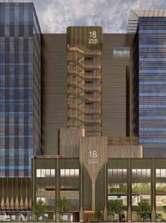

including all the tower cladding and glazing. This contributes to achieving a favourable Envelope Thermal Transfer Value (ETTV). Additionally, the high level of retention and upcycling of existing materialssuccessfullyminimisestheoverall carbonfootprintoftheredevelopment. Reconnecting with the heritage precinct
On the heritage shophouses along the pedestrian street side entrance, there are feature walls for mural artwork by local artists.
The new podium façade borrows the materiality of the green glazed terracottatilesandthewoodenstructure, establishing a dynamic relationship between the two finishes. This interplay creates distinct zones where the wooden finish and the green terracotta finish are more prominent, allowing for diversity along the 130 m-long main elevation.





The same materiality extends across the interior retail spaces, creating a cohesive experienceinsideandoutside.
TheredesignofCrossStreetisguidedbya layered approach to the interplay among
the heritage shophouses, the 20-year-old tower and podium structures, and the contemporaryfaçade.
AsRojasMachadostatedinhisinfluential paper almost 50 years ago,“remodelling is a process of providing a balance
between the past and the future.” He drew a parallel between medieval palimpsests,manuscriptsthathavebeen rewritten multiple times and carried multiple layers of overlapping writings onasinglepage,andtheremodellingof old buildings.
A very recent, smaller-scale example that exemplifies the intricate balance between old and new is Malik Architecture’s IF.BE Ice Factory repurposing in Mumbai. Malik takes the saw-tooth roof profile of the old factory building, reorienting it by 90 degrees to cover the courtyard and projecting it outward onto the street. This approach not only creates a contemporaryentrancebutalsoajourneywithinthesiteweavingtogetherelementsoftheoldandthenew;bothinside and outside.




The Power Station of Ideas in Shanghai aims to repurpose one of China’s oldest abandoned power stations, the Yangshupu Power Station. Starting its operation in 1913, it was the largest powerplantintheFarEastatthattime.It underwent several phases of expansion over the century. The most iconic 10-storey-tall boiler house built in 1938, unfortunately, was demolished years ago.

Benoy’s scheme revitalises the entire site into a vibrant, mixed-use destination. Cultural and educational facilities are seamlessly integrated with diverse office spaces, supporting retail spaces and a business hotel. The development is positioned as a sibling destination to the well-established Powerstation of Art on the opposite side of the city. Facing the main road is a sculptural reconstruction of the
demolished 1938 iconic boiler house. While the massing with the eight chimneys is restored, the design is not nostalgic. Taking inspiration from the large-scale installations by artists Do Ho Suh and Rachel Whiteread, it creates a blurry and fuzzy white envelope, evoking a foggy shadow of the past rather than a conservationist reconstruction.
A single bold sculptural gesture carves out a colonnade along the main pedestrian thoroughfare, featuring double-height glazed shopfronts.
The key arrival to the office area takes the exposed structural grid of the existing power station building, turning it into a new feature.The new structural grid hovers above the plaza, creating a unique, covered outdoor space for events, outdoor dining and pop-up markets. With the exclusion of a series of voids, this floating spaceframe houses a substantial office floorplate for an IT company. On the roof, it provides a range of unique outdoor sports and wellness amenities for the surrounding office tenants.

Case Study - 3

Moving on from heritage buildings, the secondsetofcasestudiesfocusesonthe repurposingofmoremundane,everyday buildings that lack cultural or historical value.
How can one rethink the master plan when all the structures are already built? Dunchon Apartments is a redevelopment project situated at the prominentsiteoftheoldOlympicVillage in Seoul, transforming a large residential neighbourhood. The project comprises 85 residential towers, 16 community buildings and 2 shopping centres.
The proposed design anticipates the holistic revisioning of the residential development without changing any of the existing structures. It addresses key issuesofthecurrentscheme,suchasthe monotonous repetition of the 85 towers andthespacesinbetween,aswellasthe large wall-like massing of the residential buildings.
The design started with a series of computational simulations. A pedestrian flow analysis was conducted to locate key circulation routes across this large
site and to identify the high and low pedestrian activity areas.
Environmental simulations were also employed to identify public spaces with comfortable outdoor environments throughout the year. By overlaying these two layers of data, a more nuanced differentiation of public spaces across the site was achieved. This approach led to the establishment of key nodes, which are both frequented and comfortable,
to become community centres for their adjacent residents. The large housing development was transformed into a neighbourhood by breaking down the uniformity into a series of smaller interconnected clusters of microcommunities.
The tower façades are split into lower and upper zones. The lower parts pick upthegraduallychangingcoloursofthe clusters, while the upper part features a soft reflective finish that blends with the sky. The intention is to change the perception of the height of the building by shifting the focus to the lower, colourful façade area.

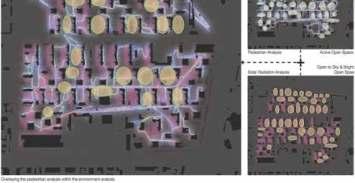
Thesplitbetweenthetopandthebottom façade zones is not constant across all the buildings. It dynamically varies across the site,creatingadiversityofexperiencesand differences between low and high-rise areas, despite the fact that the towers are allthesameheightinreality.
Toaddressthelong,wall-likeappearance ofthemassing,thetowersaresubdivided into a series of slender vertical volumes through façade articulation.The parapet heightsontheroofsalsovarytoreinforce the vertical volumes.
Although the window openings are all fixed, façade articulation is used to visually group some windows together, creating a diverse fenestration among the new vertical volumes.
On the lower façade zone, glazed terracotta cladding is used to provide a durable, high-quality finish to the building.Itbringsasenseofcraftsmanship that is not customary in large housing developments,enhancingtheexperience of people interacting with the buildings. The same level of care continues in the design of the landscaping and the public indoorspaces.
Whentheseinterventionsarecombined, they fundamentally transform the perceptionoftheentireneighbourhood; revising the masterplan without

To break down the perception of the repetitive wall-like massing, the
are subdivided into a series of slender vertical volumes using façade articulation
affecting any of the existing structure and transforming how people interact with the spaces and with each other. The ultimate goal is to foster a sense of community and facilitate social engagement. This project reinvents a residential development into a dynamic district that promotes social interactions and offers residents a playful living experience. It not only resonates with the aspirations of future residents but also boasts a sense of place.

articulation is used to visually group some windows together, creating a diverse fenestration without impacting the built structure
The redesign of the façade of the Privilion Towers in Ahmedabad followed a similar strategy.The massing was broken down into a series of box-like volumes. To differentiate between the adjacent boxes, two distinct façade systems were used: one featuring glazing and the other with deep louvers that gives a solid appearance. Between the boxes, large gaps are articulated and a series of floating platforms and green terraces were introduced. The overall perception of the massing is therefore fundamentally transformed, even though the overall structureremainsunchanged.


Abin Design Studio in their Bansberia house extension transforms a mundane house by wrapping it with a new, significantly larger screen-like skin. The spacebetweenthenewandoldenvelope creates an interesting house-within-ahouse arrangement, resembling Ungers’ seminal DAM in Frankfurt. However, in the project, there is a more dynamic interplay between indoor, outdoor and semi-outdoorspaces.
The project not only focuses on spatial designbutalsoactivelyincorporatesthe elementoftime.Overtime,thelouvered second skin gradually gives way to a thirdskinofvegetation.



The environmental potential of retaining existing structures.
(Data Source: https://www.aia.org/articles/70446-ten-steps-to-reducing-embodied-carbon, https://worldgbc.org/article/bringing-embodied-carbon-upfront/)
These examples illustrate how a series of literally superficial interventions can have a profound impact. Façade design servesasapowerfultoolintransforming underperforming buildings and neighbourhoods, infusing new life into old structures while minimising the carbon footprint. The holistic approach to revitalising buildings encompasses economic, environmental, social, and cultural sustainability and sensibilities,

GREGORY KOVACS
Design Director, Benoy
ensuring that the transformations are not only visually appealing but also functionally efficient and environmentally responsible.
By embracing adaptive reuse and innovative façade design, we can contribute to a more sustainable future, preserving our architectural heritage while simultaneously addressing the pressing challenges of climate change and urban development.
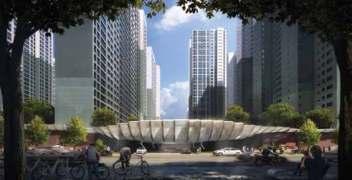
Arrival experience to the transformed, community friendly neighbourhood
Gregory Kovacs, a trained architect and engineer from Budapest University of TechnologyandtheArchitecturalAssociation in London, is a recipient of the prestigious RIBA Goldfinger Award. He has engaged in teachingrolesattheArchitecturalAssociation and the Bartlett UCL. Also given lectures globallyatuniversitiesandconferences.
Gregory’s work spreads academics, architecture, interior design, computation and art. Navigating seamlessly between these realms, Gregory injects fresh perspectives into his projects, earning numerous international architecture and interior design awards. Notably, his art practice was recently honoured with the 2023HariArtPrize.
As Design Director at Benoy, he operates within the Hong Kong, Singapore, and Shenzhen studios, overseeing diverse projects spanning Asia and the Middle East. A significant facet of Gregory’s architectural passion lies in the transformation of failing buildings and the revitalisation of neighbourhoods. Currently pursuing a PhD at RMIT, his research delves into the cultural potentials of reuse, examining both largescalearchitectureandsmall-scaleartprojects.



Since its start in 1993, Window Techs, led by Mr. Vishal Khandelwal, has been on a journey of innovation in the world of interior furnishings. The big moment came in 2011 when the company introduced Insulated Glass Blinds. This move wasn’t just business; it was inspired by Mr. Khandelwal’s experiences with ground-breaking
technology during his travels abroad. Seeing the potential for these blinds in India, he made Window Techs a pioneer in providing different blinds for various spaces,fromhomestofacades.
Facing challenges along the way, Mr. Khandelwal strategically acquired a company in Denmark to secure the technology for insulated glass blinds. This became a game-changer for Window Techs, emphasizing the company’s commitment to excellence by incorporating top-notch machinery into its Faridabad production plant.
Originally meant for facades, Window Techs’ insulated glass blinds quickly found broader use. The sleek Venetian blinds and energy-efficient Honeycomb blinds became popular for improving energy efficiency, reducing noise, and ensuring privacy. These blinds played a significant role in prestigious projects like GAIL, Tejas Train, Novotel, and AIIMS, making Window Techs a trendsetter in the industry.
Innovation became Window Techs’ signature, going beyond blinds. The company expanded its offerings to include Fire Curtains, Smoke Curtains, Wall Guards, Corner Guards, Nurse Call Systems and ZOHO Plumbing Solutions. This expansion, along with adopting cutting-edge technologies worldwide,turnedWindowTechsintoan internationally recognised brand.
As Window Techs continues to grow, its journey from introducing insulated glass blinds to diversifying its products showcases Mr. Khandelwal’s vision and the company’s commitment to pushing the limits of innovation. Window Techs doesn’t just change spaces; it reshapes the entire industry, standing as a leader in simple yet effective interior solutions. Today, as the company continues to redefine possibilities, Window Techs remains a symbol of creativity, quality, and a commitment to making every space it touches special.

For more information, contact:
PlotNo.805,Sector69,IMTFaridabad, 121004,Haryana,India
Website: www.windowtechs.co.in
Email: info@windowtechs.in
Phone: +91-9958803531



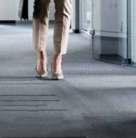
















































In a momentous ceremony, Lingel Windows and Doors Technologies Private Limited proudly opened its newest showroom in Gurugram on 6th December, marking a significant milestone in its expansion journey. Dr. h. c. Mario Schmidt, Managing Director, extended a warm welcome to all attendees and spoke on the company’s history, recently launched products, their future plan, and the new showroom.
“I am very excited about the growth of theLingeluniverse,myLingelfamilyand howthebusinesshasdevelopedinIndia. Even if challenges come, they will be faced in the same way as in the previous years. I am looking forward to the year 2024 when we will start manufacturing our windows in Romania to cater to the European market,”said Dr. h.c Mario Schmidt at the opening of the new showroom.
Her Excellency, Ambassador of Romania to India, Mrs. Daniela Sezonov Tane, graced the occasion as the Chief Guest and greeted the guests in Hindi. She spoke on how Romania and India have developed a solid and friendly

relationship over the years. Mr. Ionuţ Mircea VIZIRU, Economic Counselor was also present at the occasion. The gathering was further enriched by the insights shared by Dr. Alexandra Mittler, the Regional Director of Language Programs in South Asia, Germany.
Karl Lingel, the Chairman of Lingel, expressed his delight and greeted the gathered guests, shedding light on how Lingel Windows’ journey in India began, and the customers catered to in Germany. He also spoke about the new manufacturing unit coming up in Romania.
The ceremony also witnessed the unveiling of a new range of cuttingedge products, showcasing Lingel’s commitment to innovation.
The event attracted a distinguished audience, including prominent figures from the industry, architects, channel partners, and loyal Lingel customers. The inauguration not only marked the expansion of Lingel Windows but also emphasized its dedication to delivering quality products and services. The new showroom stands as a testament to Lingel’s continuous pursuit of excellence in the world of windows and doors.
Karl Lingel Fensterbau Gmbh & Co was established in 1959 in Ellwangen, Germany. Since then, Lingel has been one of the leading manufacturers of high-quality doors & windows in Europe Lingel has two manufacturing units one is in Ellwangen & second is in Lichtenstein and has 60 plus years of experienceinfenestrationInIndiaLingel set foot in 2006 with its Head office in Rewari, Haryana.

For more details on the product, contact:

123106India
Website: www.lingelwindows.com
Email: mario@lingel.in
Phone: +919870273743













Saugaat Inc. is unwavering in its commitment to pioneering innovative products and cultivating a diverserangetocatertoallcustomerneeds seamlessly.Ourcommitmentisexemplified through our role as a comprehensive solutionprovider,particularlyinthedomain of insulated glass (IG); we are positioning ourselvesasthedefinitiveone-stopsolution for all essential needs in glass processing materials. Beyond product offerings, our commitment extends to resolving technical challenges inherent in the glass industry, showcasing our unwavering pursuit of excellence in meeting the nuanced demandsofourclientele.
Saugaat Inc. fosters close collaborations with industry leaders such as Kuraray (Japan), H.B. Fuller|Kommerling (USA), and Elkem (France), working collaboratively to innovate products and tackle technical challengesintheglassindustry.
H.B.Fuller(USA),aprominentplayerinthe adhesive industry, has collaborated with Kommerling (Germany) to emerge as a leading provider of vital primary sealants indispensablefortheprocessingofinsulated glass (IG). Our sealants boast exceptional qualities, including high flexibility at low
temperatures, remarkable resistance to chemicals and weathering, and excellent adhesion properties. These attributes collectivelycontributetotheoverallreliability of our sealants, making them exceptionally versatile for application across diverse commercialmarketsandscenarios.
With a legacy extending over 125 years, Elkem(France) hasconsistentlypositioned itself as a dependable provider of highquality silicone sealant products, adhering to stringent quality standards within the building & construction sector. The recent introduction of project-oriented secondary sealants, namely STARSILTM SLT 9100 and STARSILTM SLT 9100, in India signifies a significantleapfortheconstructionindustry. These sealants provide versatile solutions, ensuring both reliability and optimal performance,therebymakinganoteworthy contribution to the sector. Going beyond insulatingglasssealants,Elkembroadensits product line to encompass various silicone

sealants, reinforcing its commitment to addressingdiverseindustryneedswithtoptiersolutions.
Kuraray (Japan) is dedicated to advancing innovative technologies that contribute to global environmental improvement and an enhanced quality of life, exemplifying itscommitmenttoexploringnewbusiness avenues. Notably, Kuraray has introduced the ground-breaking Trosifol® Spallshield® CPET, a state-of-the-art solution that surpasses expectations in lightweight construction, penetration resistance, and anti-spalling capabilities. This cutting-edge product features a sophisticated twolayer composite structure composed of PET/hardcoat. The hardcoat, renowned for exceptional durability and chemical resistance, seamlessly integrates with the composition, presenting an appearance virtually indistinguishable from glass. Trosifol® Spallshield® stands out as a pioneering solution, delivering superior lightweight anti-spall properties to enhancetheresilienceofglazingstructures significantly.
Furthermore,SaugaatInc.activelyengages inthecontinuousdevelopmentofcuttingedge and innovative products, poised to meet the dynamic demands of the evolvingmarketlandscape.
For more details on the brand, contact:
Saugaat INC.

Headoffice: 9, Kaopte Meher Market, Wadala Naka, Nashik, Maharashtra India. 422001.
Email: saugaatinc@gmail.com
Tel: +91 253 2597864
Mob: +919664561331
Mob: +917057888158

Art-N-Glass, India’s leading glass processor, showcased their groundbreaking, revolutionary glass canvas project and an impressive six-meter door and slider at the recent ACETECH exhibition held in New Delhi. Thismarksthefirsttimesuchanextensive doorandsliderhavebeenexhibitedatan event in India, setting a new standard in theindustry.
SwapnilPathak,Director,andthevisionary behind the glass canvas project at ArtN-Glass, shared the inspiration behind this unique endeavor. Recognising the limited exploration of glass as a material in architectural design, Art-N-Glass collaborated with ten top designers to conceptualise designs exclusively using glass. The result was the glass canvas project, an ode to the limitless potential of glass as a material. Swapnil expressed his passion for glass, emphasizing its significance not just in India but on a global stage. The project, completed within an impressive 72 hours, aims to
encourage other companies to explore theboundariesofglassintheirrespective cities.
Adding to the showcase, Satvik Pathak, Director and Art-N-Glass’s main designer, introduced the six-meter door and slider. Motivated by the need to bridge luxury and technology, Satvik emphasised the reinvention of traditional sliders and doors. The showcased products feature cutting-edge technology, allowing a 1,000 kg slider to be effortlessly operated with just one hand in a temporary structure. The six-meter door, a mere 32mmthick,exemplifiesaseamlessblend of technology and vision, showcasing the company’s commitment to pushing boundaries.

Satvik highlighted the global perspective that inspired these innovations, noting that Art-N-Glass observed exhibitions worldwide but found nowhere a slider as massive as the six-meter one they unveiled.Thecompanytakesprideinbeing the sole indigenous producer in India capable of manufacturing such products, differentiating themselves from others who importtechnologyfromtheWest.
Art-N-Glass’s remarkable ability to erect and demonstrate the functionality of these colossal structures in just three days reflects their commitment to staying at the forefront of industry advancements. The team envisions a future where sixmeter heights and beyond become commonplace, with Art-N-Glass leading the way in designing and manufacturing groundbreaking glass and aluminium products.
As the ACETECH exhibition drew to a close, Art-N-Glass left an indelible mark on the industry, sparking inspiration and redefining possibilities for glass and aluminium in architectural design. The company’s ambitious projects, coupled with their dedication to innovation, position them as pioneers in the field, promising a future of even more extraordinarycreations.
For more details on the product, contact:
Art N Glass Inc.
1/118, W.H.S., Kirti Nagar, Near Fire Station, New Delhi
Email: sales@artnglassinc.com
Website: www.artnglassinc.com
Contact: 011 47 630 400



Aluminium doors and windows have become synonymous with modern architecture, seamlessly blending structural integrity, aesthetic appeal, and energy efficiency. In this transformative landscape, KinLong emerges as a trailblazer, reshaping industry standards through its innovative approach to aluminium door and window hardware. With a commitment to innovation & customisation, KinLong plays a pivotal role in defining the future ofmodernarchitecture.
KinLong’s unwavering commitment to thealuminiumdoorandwindowindustry


is evident in its comprehensive product range, transcending conventional standards. The company’s dedication to diversification and innovation ensures it meets the diverse and evolving needs of its clients. The locking hardware range includes meticulously designed componentssuchashandles,lockbodies, transmission rods, and more, setting the stage for top-quality, secure, and efficient doorsandwindows.

Beyond locking hardware, KinLong provides load-bearing solutions with hinges, friction arms, and rollers tailored for various applications. The company’s range of limiting accessories enhances safety and usability while supporting accessories contribute to the overall efficiency of the working mechanism. KinLong’s holistic approach extends to EPDM rubbers, specially designed for aluminium extrusions, offering unmatched customisation. The company’s screws and fasteners, Nylon Anchor frames, and glass fixings further exemplify its commitment to providing a comprehensive range of products for everyproject’suniquerequirements.
At the heart of KinLong’s operations lies a dedication to manufacturing excellence. The company’s cutting-edge facilities maintain the highest standards of quality and precision in the production
of hardware components. Rigorous quality checks and stringent material testing processes ensure that each product surpasses industry expectations. KinLong’s state-of-the-art capabilities enable the crafting of bespoke hardware solutions for clients with the most exactingspecifications.
KinLong’scommitmenttotheconstruction industry extends beyond hardware supply. The company provides comprehensive support, including solution drawings tailored to hardware suitability with various profiles. This service streamlines the integration process for architects, builders, and manufacturers, enhancing project efficiency. By presenting a complete package of diversified solutions, KinLong simplifies the procurement process, empowering the industry to push boundaries and achieve innovative breakthroughs in construction. In a rapidly evolving construction landscape, KinLong stands as the trusted partner, providing expertise&solutionstoensuretheindustry’s continuedsuccess.

Formoredetails:

+91-9108990181


“Alcomb, an Aluminium Honeycomb “Alcomb, an Aluminium Panel from Alstone, is a Top-Notch Panel from Alstone, is a Top-Notch Choice for Any Architect or Façade Choice for Any Architect or Façade Consultant”

Sumit Gupta, the Managing Director of Alstone, at the age of twenty-three, encountered the concept of Aluminium Composite Panels while on a trip abroad and envisaged its great potential in the construction and building sectors. This motivatedhimtobeginmanufacturingACPdomesticallyin2003,andhehasnot looked back since. Currently, after almost two decades in the field, Sumit Gupta considershimselfanACPevangelist.Hismotivationandenthusiasmforbusiness growthandmanagementtechniquesarewhatfuelhim.Inheritingthetraditional businessacumenofhisparents,alongwithhisMBAqualificationandknowledge of the industry, he has been able to take the Alstone Group to new heights and continuously redefine their objectives.
WFM Media interviewed Sumit Gupta, discussing his career as the Managing Director of Alstone, the company’s products and manufacturing facilities, their latestlaunchinthemarket,Alcomb,hisvisionfortheyear2030,andmuchmore.

Could you please tell us about your company,Alstone?
Alstonestarteditsjourneywaybackinthe year 2004. And, we have completed 20 years of presence in the Indian cladding market. With this, we have got pan-India presence as of now with our 16 sales offices cum warehouses, along with 350 dealers across India. I feel honoured and proudtosaythatAlstoneisnowaknown brand in the cladding industry market. And all architects, façade consultants, developers, and consultants know Alstoneverywell.
What are the products manufactured byyourcompany?
Alstone has been a leading brand in the claddingindustryforalmosttwodecades now. At Alstone we manufacture a wide range of Metal composite Panels with Manufacturing Unit in India and Dubai (with Brand name “Emerge UK”} to cater the demand of national and international markets.

Asofnow,wehaveawideproductbasket and we are not only manufacturing standard aluminium composite panels (ACP), but we are also manufacturing class B and class A2 (noncombustible) composite panels, apart from that, we are also now into zinc cladding, which is our premium cladding for buildings nowadays which is very much liked by today's architect and façade consultants. Wealsohavemetalcompositelouvers,and metal-basedHPLinourproductbasket.As you see, we offer quite a good number of productoptionsforexteriorcladding.
Where is the Façade Industry leading to?
The façade industry, what I can observe is moving very fast and I can see that it

is now getting much more mature in terms of its demand for sustainable and green products., Alstone has already stepped forward by bringing in one of the innovative products which is an aluminium honeycomb panel with the name Alstone Alcomb. It is a green and sustainable product. Architects and façade consultants have really liked our Alcomb product range because of its uniqueadvantagesoverthestandardACP.
Could you please tell us more about yourhoneycombproduct,whatareits

advantages? And how can it change thefutureofthefaçadeindustry?
Honeycomb panel is our latest and versatile product which is completely madeupofaluminum.Thereisnoother material used in its composition. Or I can say, it is a 100% aluminium-based product. It's a very lightweight material because of its honeycomb aluminium core structure inside. It is not only lightweight,butit'saveryrigidmaterial. The strength of the material is far superior to a standard ACP panel and it is also a non-combustible panel in terms of fire rating. It comes under A2 grade, andthethermalandacousticproperties of this product are far superior. So, all these USPs make this product a topnotch choice for any architect or façade consultant.
Do you want to say something more about its technical features and installationprocess?
One thing I would like to highlight is that the Alstone’s Alcomb product’s strength is so strong that you can have 6, 8, or 10-meter-longpanelswithout




back support or a stiffener, which is generally required, even for a smallsized panel of ACP. So, that is one of the major USPs. If we are talking about the installation side. Architects love to have long panels without even a single joint in between.
The Indian market is highly competitive. How do you manage to keep the consistency to be one of the leaders? And how can this producthelpyouinmaintainingyour leadership?
What I understand is that India is a huge market with different segments within the market. There is a top market, which is also a very niche market, where only quality and innovation play a big role. So, if you talk about Alcomb, we are very clear that we will take this product in the niche market where quality and innovation are majorly in demand. Customers want good quality products along with a complete wall solution. In this case, we are not just going to supply the honeycomb sheets or panels, but we are going to provide a complete wall solution along with fixing system.
Foralmosttwodecades,ourdedicationto quality and innovation has earned us the loyalty of our customers, who know that weneversettleforlessthanthebest.
Alstone products are already known for their technically advanced machines which are used to make it and give improved features to the façade. Could you please explain this?
Alstone has always been focused on innovation and new product development. This is one of the features of Alstone for which it is known in the market. Our latest entry, which we have just discussed about - our honeycomb product “Alcomb”, we have established a state-of-the-art manufacturing plant for thisproduct.Andwewantthisproductto comeouttechnicallystrongandfitforany ofprojects.
How do you differentiate Alstone products from the other brand's products and what are the advantages of using Alstone products for façade and wall cladding, etc.?
I feel the market knows very wellbe it retail or be it projects. Alstone has always delivered quality to all its customers, whether it is a smallsized site or it's a big project. We have been very focused on our quality standards at every step of production, right from procurement to the point where we deliver the product to the customer side. We ensure that at every step we have a quality process and we ensure that every product delivered is of the best quality.
One of the most critical values of Alstone is innovation. We were one of the the first ones in India to introduce a rangeofinnovativeproductslikelouvres and fin louvres. These are very recent examples other than Alcomb - Alstone Honeycomb panel, FR rated aluminium compositepanels.
We invest consistently in research & development to ensure future-ready products for amazing cladding and a safeenvironment.

To support the Dream of our honourable PM Narendra Modi, Alstone is relentlessly working on Green Building Solutions with fire safety features and Net Zero Concept in cladding along with end-to-end solutions. We provide the Consumer with customised solutions as per their specifications and need.
What testing and certification methods do you follow for your Alcombproducts?
All our Alstone products, particularly, class B and class A2 grade products are tested by Thomas Bell Wright - an international test lab based out of Dubai. That is one of the major testing lab in the world. We have also got our product tested and certified by Winwall laboratory in Chennai. And, I feel proud to inform that Alstone is the first ACP company in India that has got NFPA 285 test successfully conducted in India withWinwall Systems, Chennai.
Also, in our in-house laboratory, all of the product batches are evaluated for their strength and longevity before they are sent out of the production facility. This way, we can be sure that we are consistently providing our customers with the same trustworthiness and excellence.
What are the prestigious projects in which Alcomb products have been used?
So Alcomb is the latest entry in our product basket. But within the short period, we have been able to get two of the big, massive projects in which one project has already been completed, where we have supplied 14,000 Sq m


of our Alcomb honeycomb panels. The project is one of the Airport Authority of India’s projects, known as Civil Aviation Research Organization (CARO) building, which is in Hyderabad. So, this project hasalreadybeenhandedover.And,ifyou see that building itself, shows the beauty and strength of the Alcomb panel, which has been used in the entire cladding of thatbuilding.TheotherprojectisGwalior Airport where we have already supplied honeycomb Alcomb panels. This project is expected to get complete in the next threemonths.
What are the major challenges you find in the industry and how do you cope with those?
Every industry I feel has one or the other challenges. It's just that you need to understand the challenges and work constantly to overcome those challenges. Besides that, I also feel that in every industry, there are a lot of opportunities also, one needs to be on their toes to grab those opportunities and gain first-mover advantage by working as a front-runner.
Could you explain your distribution system and how it helps with the timely delivery of your products?
We possess sixteen branch offices and warehouses throughout India, where we guarantee the timely delivery of our

products across the country. Moreover, we have a state-of-the-art Coating line to provide consumers with personalized shades of cladding at a faster and smoother pace. Additionally, our dealer and distributor network consists of around 350 channel partners, located in PAN India, whose main goal is to serve our customers and consumers On Time In Full. Additionally, we have a specialised sales force who make sure to connect and communicate with all the influencers, channel partners, contractors, and various departments in both public and private domains to provide all necessary support.
What are your plans and vision for 2030?
We are talking about seven years from now… I feel that the industry will be playing at a different level altogether. We do not know really where these architects and façade consultants take this and to what level. But as Alstone, I would say that we are very aggressive and active in having a lot of new products for the future in our basket, which would not just be innovative, but also sustainable and green products. I feel that by 2030, we will be having most of the products only green and sustainable. These new products would be very different from what we have been manufacturing currently.
We are absolutely thrilled to announce that WFM Media and Window and Façade Magazine have reached an exciting milestone – we are celebrating our 10th Anniversary. We take this occasion to thank each one of you – our subscribers, contributors, brands associated with us, industry leaders, our advisors, and our well-wishers for supporting us and encouraging us continuously. We are grateful to all of you who trusted us and stood with us in our journey. Your demands and feedback have pushed us to go ahead and improve vigorously. Our success story remains incomplete without the support of you all. Not only have you made us a part of your life but also helped us reach out to the world. We can’t thank you enough for your contributions to WFM Media. On this auspicious occasion, we plan to keep our business and relationship growing with you and continue to provide you with nothing less than the best. With your support, we wish to explore new heights in the coming years.
ABHINAV GAIND
Partner, Mixx Windows

Congratulations WFM on completing 10 years. It’s been great associating with your team!
“
ABHISHEK KALE
Area Manager India, Sorbinco

Wishing WFM team on their 10th-anniversary celebrations. Sorbinco, one of the premium hardware fittings, wanted to get associated with WFM, who value their work, right from the beginning.WFMalwaysgivesvalueaddition,anditisapleasure to read. The team is reciprocative, and we are looking forward to continuing the same relationship with them in the future.
“ABHISHEK AGARWAL
President of Strategy at Ozone Group

We wanted to wish and congratulate WFM Media. A very hearty congratulations from everyone at the Ozone Group for completing 10 years. We have partnered with WFM on multiple events, media creations, etc. over the past 10 years. It’s been an incredible experience.
AJAY TENANY
Managing Director, Siegenia

I am here to congratulate WFM Magazine. They have completed a decade in the industry. They have been the only source of information for the facade industry, introducing new companies, introducing new technologies and products around. Thanks for keeping us updated and all the very best to you.
“ANGSHUMAN SARKAR
Country Head Sales, Costswold

Heartiest congratulations to WFM for completing 10 years. And you are doing a wonderful job connecting the fenestration industry together. WFM Media helps in promoting the brands and products through prints and social media. I wish them all the best in their future.
T.S. ADITYA
Associate Vice President - Sales, FunderMax India

Congratulations to the WFM team for completing 10 years. In the past decade, we have seen phenomenal growth. Your magazine and your topics are very interesting. You guys are covering vast topics related to the facade and fenestration industry. Wish you all the very best for the next decade.
“
ALLEN CHEN
VP & Managing Director, Kinlong Hardware India Pvt Ltd

Congratulations on reaching this milestone. From its humble beginnings to its current status as a respected and widely read publication, the magazine has certainly come a long way. Happy 10th Anniversary to WFM Magazine!
AVANISH SINGH VISEN
Director & CEO, ENCRAFT India Pvt. Ltd.
(Part of DCJ Group)

Cheers to a decade of inspiration and innovation! As WFM Media marks its 10th Anniversary this December, as you reflect on a journey filled with insightful stories, thought-provoking content, and unwavering support to the readers. – here’s to a future of continued collaboration and excellence!
“BERK SECKIN (Group) CEO, DOCTOR WINDOW

Congratulating Team WFM on completing 10 years in India. I am thankful to Amit Malhotra and his team for your support. You are really doing a great job always.
FARID KHAN
Director & CEO, profine India

Heartiest congratulations to Window and Façade Magazine on achieving the milestone of the 10th Anniversary edition. It is the consistency and commitment to creating quality content that stands WFM apart from others. Wishing many more years of achievements and growth.
GAURAV OSWAL
Director, Kelegant

I would like to congratulate WFM for completing 10 years of their edition. They are doing a great job of connecting and binding the industry together. This is one of the few best platforms where the industry is coming together, speaking about the industry. We get to know about the current industry trends, the future, and the expert’s views, and we get to read good articles.
DEEPAK PHOGAGDE Managing Director, Elumatec

Congratulations to the WFM team for completing 10 years of success story with us. And I wish you the very best. They are doing a great job, by contributing to this industry. We are very happy working with them. We will continue to work with WFM always because they are very supportive. I hope that they will continue the same support, to the industry and us. I wish the best of success to the WFM team.
“
GANESH SABAT
Sales and Marketing Specialist, Jindal Aluminium Limited

Happy to know that WFM Media is completing its 10th anniversary. Best wishes to the team for your future.
“ “
HERAT
MEHTA
General Manager, Technoform

I would like to congratulate WFM on their magazines’ 10th anniversary. It just looks like yesterday, and 10 years is a long journey. The most important thing about WFM I see is the WFM team has documented the façade and fenestration industry and has circulated the same throughout India. It has never been done earlier and is a big task. I wish them all the best for their future and another decade.
HEMJITH VENGATERI
President and CEO for Asia Pacific, Alumil Systems

Since we started our operations in India, in 2014, we have been associated with WFM, for almost every edition of the magazine. I’m very happy to see the growth, that has been. WFM Magazine has played a role in connecting the industry with the various government bodies, and they are doing a tremendous job of bringing our industry standards to another level. So I appreciate the team for their hardwork and dedication to whatever work they are doing for the betterment of the industry.
JOTHI P. RAMALINGAM PONNUSAMY
Director,
Winwall Technology India Pvt Ltd

Hearty Congratulations to the WFM team for successfully publishing this magazine for the last 10 years. Winwall has been associated withWFM for the last 10 years since we started our work in India. I would say that the WFM team has done a stupendous job. The Facade and Fenestration industry owes a lot to WFM for sharing knowledge on the latest developments in this industry thus helping it improve itself to face the future. Winwall India wishes you many many more years of successful publishing.
KARAN SHAH
Founder, PEGO Hardware

Congratulations WFM on an incredible journey of being the voice of the Indian fenestration industry. You have provided the platform for the best practices that can be shared with the industry and large. Wishing you all the best going forward.
“ “ “ “
KESHAV BABU
Director, FOM Aluminium Machines India (P) Ltd

Team WFM, you are doing a great job, publishing market trends, and reviews and doing the best in technologies, AI, design, AI methods, futuristic analysis, and what came to the market and we are proud of you. Congratulations to you!
MANISH BANSAL
Director & CEO, Window Magic

Congratulations, Window and Facade Magazine on a glorious decade in the industry! Your insights on facade and fenestration, from materials to designs, trends, and tech, keep the audience hooked as the digital world transforms.
Here’s to ten years of triumphs, with more on the horizon! Cheers,
MARIO SCHMIDT
Managing Director, Lingel Windows Doors Technologies Pvt. Ltd.; President - UWDMA.

Congratulations WFM Magazine… Such a great goal, such a great achievement.Tenyearsintheindustryisalongtime.AndIstillremember way back in 2013, when we featured the first write-up. We are always ready and happy to deliver content. UWDMA is an umbrella of the industryandWFMisthevoice,themedia,istheplatformtojustshowcase or project the achievements, the latest news, and the innovations of the industry. Thank you, WFM for giving us the opportunities during all the years. All the best for your future endeavours.
MUKESH SRIVASTAVA
Business Head – McCoy 8m

Congratulations to WFM Media Team for completing 10 years. The job you are doing is commendable for bringing the industry together on a single platform. I wish all of you the best for the future and many more years.
NANDA KUMAR
Director, Prominance Windows

Congratulations to WFM for completing their 10 years. We have been associated with them from day one. WFM has supported a lot in taking our brand to the market, and they are doing a wonderful job in the architectural fraternity and also for the end consumers, guiding them properly on different architectural products as well. And we’re proud to associate withWFM. Good luck. I’m looking forward to getting into much more progress in the future.
NAVI AHUJA
Director, G-U (Gretsch-Unitas)

It is very good to hear that WFM has achieved that milestone of 10 years. I Congratulate WFM team for completing a successful decade. They are the voice of the industry. They have always given very good information to their facade & fenestration community.
Best of luck for achieving more in another 10 years.
NIKHIL JAIN
Director, Alpro Industries, The Rishabh Winpro Pvt Ltd

I congratulate WFM for completing a milestone of 10 years of achievement. Whatstartedasadreamhasactuallybecomearevolution. I congratulate them on actually educating not only the industry but also the people who are not related to the industry and explaining to them the importance of facades and fenestration in providing interior comfort and building occupancy. I wish them all the good luck and hope they continue doing a great job for many more decades.
PIYUSH SRIVASTAVA
Country Head, Hydro BS India Private Limited

We have contributed several articles and I would like to congratulate WFM team for completing the 10 years. As a pioneer in this industry, we are talking about creating and sharing knowledge and information. So the whole WFM fraternity is a Solution sharing platform. Wishing the team a great future.
“ “ “
PRADEEP JAIN
Managing Director, GB Enterprises

Many, many congratulations to WFM Media. You all are doing a good job for the industry. And we hope you keep doing great work, spreading knowledge, in future also.
PRASHANT KUMAR
Country Manager India, Pertici Industries Italy

I want to congratulate WFM Media for completing 10 years. Your work is commendable. I wish for you an excellent future. All the best!
PUNEET AGARWAL
Country Head, Wonder Alu Board Overseas

I would like to congratulate Windows & Facade Magazine & WFM Team for completing their 10 years. My association with Windows & Facade Magazine is being also now 10 years old, and I read every edition of the magazine. WFM and the magazine have created a niche market for itself by exploring a new segment that every other magazine has ignored, and they have created a special space for themselves, and I think it has made a big impact in the industry.The other best thing about the WFM magazine I like is its great content, not only the 0from India, but from overseas consultants. It is a very balanced magazine in terms of the advertisement and content.
RAMAN DHIMAN Director- Sales & Marketing, Insta Hardware

We have been associated with WFM for almost six years now. Through this magazine, we came to know about the industry growth, industry patterns, new products, and new trends. Your contributions have been invaluable to the window and facade Industry. Congratulations to the team on the 10th anniversary edition and continued success in all your endeavours for the progress of the Industry.
RAHUL JAIN Director, GB Enterprises

I want to congratulate the WFM Team for completing a successful decade. We have a great association with the WFM team and are very supportive. They are doing a good job for the industry and also are becoming the voice of the Industry. All the very best Team WFM.
RAVI BALAKRISHNAN
Managing Director, aluplast India Pvt Ltd

Hearty congratulations to WFM media on the 10th anniversaryofficially into double digits.There are many magazines, which cover building and building-related products and also the fenestration industry. But among them, WFM has always stood out, bringing out innovations, and giving a lot of information to the stakeholders and I wish them all the best for the future. Wishing you many more successful years ahead – Bigger and Better.
“
SANDEEP KANDE
Founder and Managing Director, Window Expert Industries Pvt Ltd

On behalf of Window Expert Industries Pvt Ltd, I would like to extend our heartfelt congratulations on your remarkable achievement of celebrating your 10th anniversary. This is truly a significant milestone in the world of media and publications.
Warmest congratulations once again on your 10th anniversary!
SANJAY JAIN Director, Mozart

Congratulations on the 10th anniversary of WFM, Window and Façade Magazines. We are very grateful to the WFM team. We have been associated with WFM since 2015. They have been very cooperative.
SATISH KUMAR
Group Business Development, Director, Asia & Australasia, Deceuninck Group

Congratulations Renu, Kapil and the entire WFM team. Keep updating us about the latest developments in the Window and Facade industry from across the globe. Cheers!
“
SANJAY MEELA
Director, Sudhakar Profile Systems

We are here to congratulate, uh, WFM for completing a decade of success, and we wish all the very best for future endeavours.
“ “ “
SHOBHITA MISHRA UWDMA

Congratulations to WFM Media for completing 10 years successfully. And, we are very thankful to them. And we look forward to many opportunities to work together in the coming years for the industry. And we look forward to it so much.
SHYAM RAGHUNANDAN
Managing Director, Schueco India

WFM has been a partner almost since the day we started. And they have been a huge support to raise the level of the industry, drive innovation, drive service. They have been a benchmark in how to spread the word of all the innovations that all of us in the industry are bringing together. I wish the team WFM all the best and wish them great success, and great happiness for the next 10 years as well.
SUHEL KACHWALA
Managing Director – FG Glass

It has been a pleasure to be associated with WFM Magazine for a decade and it’s been an incredible journey. The WFM magazine’s commitment to showcasing innovation in the glass and facade industry, coupled with insightful articles by industry leaders, has truly shaped the future of construction. FG is proud to contribute to WFM and excited for what the future holds!
SUMIT GUPTA
Managing Director, Alstone

SAYED ANWAR
Regional Sales Director - South Asia, Tyman International WFM Team has really worked very hard & they have created a brand for themselves in the industry. Whenever I visit any architect’s office, I generally see this magazine lying on their table. I would like to wish Window and Façade Magazine all the best and congratulations on completing 10 years!

Congratulations WFM team for completing 10 years!
TARIQ KACHWALA Director, FG Glass

I would like to congratulate and also appreciate the fantastic work that the WFM team has done over the past 10 years since its existence. It really is a commendable effort because, before this, there was no exclusive publication for this industry. This is a global & dedicated publication for the façade industry. And in general, the façade industry has come such a long way from where we were, say, a decade or a decade and a half back.Today you see all these wonderful products around us.
“ “ “
ULLAS GULIANI
DGM - Business Process, profine India Window Technology Private Limited

Congratulations WFM on your 10th anniversary. May this milestone be just the beginning of a continued legacy in providing quality content for the industry. Best wishes for the next decade of achievements.
VINAY SINGH
Director, Osaka Rubber Pvt. Ltd.

Firstly, I would like to congratulate Team WFM for completing its 10th successful year. And we have been associated withTeamWFM for a long time, since its inception. And they are giving the right information about the industry, new products, launches and more. We are very happy to associate with Team WFM. All the best, Team WFM. Well done.
VIKAS MALHOTRA
Managing Director, DNV Global (p) Ltd.

Many Congrats to WFM for completing a successful journey of 10 years. Your reach has been to all the targeted clients which gives the best Platform to get associated with you. Wish you all the best for future success as well. I’m really happy to see the reach you have., you networking. And I see our future with you and your future is so good. All the best, WFM and the team.
VIKRAM KHANNA
COO- Consumer & Architectural Institutional Glass, CMO- Asahi India Glass Limited

Congratulations to WFM Media from AIS on a decade of excellence! Your commitment towards showcasing fenestration & architecture has truly transformed the industry. AIS is proud to have contributed valuable insights to WFM’s articles, our association has been instrumental in promoting innovation and excellence in the Glass and fenestration industry. Here’s to inspiring insights and many more years of success. May the next decade be even more spectacular!
YOGESH GHADIYA President, Kaka Industries Limited

Happy to know about the 10th anniversary edition of WFM. Congratulations and best of luck.
VISHAL KHANDELWAL
Managing Director & CEO, Window Techs India Pvt Ltd

We are associated with the WFM team for the past 10 years. I congratulate them for completing one decade in this industry. Great work everyone! Thanking you for all your good work for the industry.
“
YP SINGH
Technical Director, Fenesta Building Systems

Congratulations to the entire WFM team on a successful and inspiring 10th anniversary!
WFM has surely bridged users, manufacturers, technocrats, innovators, designers and the entire fenestration industry together to share and co-create the future of fenestration. Wishing WFM to continue its journey for many more decades to come!!




The façade and fenestration market in India has witnessed notable evolution in recent years, largely influenced by changing architectural preferences, advancements in technology and sustainabilityinitiatives.
Doors and windows have great importance in the minds of the consumer while planning for a new building or renovating the existing building. The overall façade and cladding market is at an estimated 100 million square meters. The growth rate in the past was at 12-18% and the demand is rising because of an increase in awareness about sustainable construction, not only for aesthetics but also for functional values.
The performance of the façade & fenestration industry would be proportionate to the performance of the Indian real estate sector. The Real Estate Industry in India Market size is estimated at USD 0.33 trillion in 2024 andisexpectedtoreachUSD1.04trillion by 2029, growing at a CAGR of 25.60% during the forecast period (2024-2029).
The India façade market size reached US$ 2,855.4 million in 2023. Looking forward, the market is to reach US$ 5,431.9 million by 2032, exhibiting a growth rate (CAGR) of 7.18% during 2024-2032 (IMARC Group report). The increasing construction activities, the risingnumberofcommercialspaces,and thegrowingnumberofremodellingand upgradation projects represent some of thekeyfactorsdrivingthemarket.

WFM Media Team interrogated many experts, including architects, window and door manufacturers and façade and fenestration consultants, to gather information on the ongoing industry market,trendsandperformance.Inthis edition’scoverstory,weareclubbingthe facts we assimilated to give our readers a fair idea of the performance of the industry considering the current state and the future perspective, considering 10yearsfromnow.
Readers of this edition’s cover story will benefit from the amalgamation of industry insights, providing them with a well-rounded understanding of the currentindustryperformanceandtrends, andaglimpseintothefuturepossibilities ofthefaçadeandfenestration.

The world of architecture is constantly evolving, and one of the most dynamic aspects is façade design. In the past year, several trends have emerged, reshaping the way buildings present themselves to the world. From innovative materials to sustainable practices, the façade landscape has witnessed a fascinating transformation.
One notable trend that gained momentum in the past year is the use of dynamic façades. Architects and designers are increasingly incorporating elements that can adapt to changing conditions. Dynamic façades respond to environmental factors such as sunlight, temperature, & wind, optimising energy efficiency and user comfort.This not only enhances the building’s functionality but also adds a layer of interactivity to its exterior, creating a dynamic visual experience.
Sustainability continues to be a driving force in façade design. In the past year, we
haveseenasurgeintheuseofeco-friendly materials & energy-efficient technologies. Green façades, featuring living plants as part of the building envelope, have gained popularity for their aesthetic appeal and environmental benefits. Additionally, solar-responsive façades, equipped with photovoltaic panels, showcase a commitmenttorenewableenergysources, merging sustainability with technological innovation.
Material experimentation has been a key theme, with architects pushing the boundaries of traditional construction materials. Transparent façades employing advanced glass technologies providebuildingswithasenseofopenness while maintaining thermal efficiency. On the other end of the spectrum, the use of unconventional materials like perforated metal panels and composite materials has expanded, offering architects new

Sustainability continues to be a driving force in façade design

The façade landscape is poised for further innovation possibilities for texture, pattern, and visual interest.
Minimalism has maintained its stronghold in façade design throughout the year. Clean lines, monochromatic palettes, and simple geometric shapes

continue to dominate, reflecting a timeless aesthetic that complements various architectural styles. The emphasis on minimalism not only contributes to a modern & sophisticated look but also aligns with the growing interest in decluttered,functionalspaces.
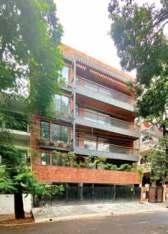
A trend that has gained traction and shows no signs of fading is the integration of smart technologies into façades. From interactive LED displaystointelligentshadingsystems, buildings are becoming increasingly responsiveandcommunicative. Smart façades not only enhance visual appeal but also contribute to energy efficiency by optimising natural light and ventilation based on real-time data.
Looking ahead, the façade landscape is poised for further innovation. The coming year is likely to witness an increased focus on biophilic design, emphasising the connection betweenhumansandnature.Façades featuring more greenery, natural materials, and designs inspired by organic forms are expected to take centre stage, fostering a sense of well-being and harmony with the environment.
Moreover, advancements in nanotechnology may revolutionise façade functionalities. Self-cleaning and self-healing materials could become more prevalent, reducing maintenance costs and extending the lifespanofbuildings.Theseinnovations not only address practical concerns but also contribute to the overall resilienceandlongevityofarchitectural structures.
In conclusion, the past year has seen a diverse range of trends shaping the façadedesignlandscape,fromdynamic and sustainable solutions to material experimentation and technological integration. As we look forward, the fusion of biophilic design principles and cutting-edge technologies is poised to define the next chapter in façade innovation, promising a future where buildings not only reflect our values but also contribute to a more sustainable and visually captivating urbanenvironment.

AMRIT S PATEL
Managing Director, Sohom Fenster Tech Pvt Ltd
Fenestrations & façades play pivotal roles within the architecture of habitable buildings.These elements not only shield occupants from external weather extremities but also foster an active engagement with the outside world while preserving indoor comfort. With technological advancements influencing diverse industries, the realm of fenestration has witnessed the emergence of innovative materials, includinguPVC.
Unlike traditional materials like timber, uPVC for doors and windows is artificially engineered. Consequently, manufacturers of uPVC doors and windows face certain limitationsindesigninnovationcompared to the creative liberty enjoyed by skilled carpenters. Nevertheless, the professional design specifications integrated into uPVC door and window construction lay a strong foundation. Local manufacturers, when adhering to these design guidelines, can significantly enhance the final performance of these installations, surpassingconventionalcounterparts.

Although uPVC as a material for doors and windows arrived in India later than in the Western world, the market here initially featured rudimentary offerings in contrast to the more advanced uPVC installations prevalent in Western countries. India’s market for uPVC doors and windows is evolving and maturing, pivoting towards delivering on its promises. However, in a developing economy where price often outweighs performance considerations due to the vast population, scepticism regarding the performance of uPVC fenestrations persists.
To unlock the full potential of uPVC fenestrations in India, meticulous attention is imperative at every stage— from embracing the original designer’s concepts, ensuring suitable openings for installation, and adhering precisely to manufacturing guidelines, to the final

installation process. Any compromise, drivenbycostorotherfactors,mightlead tounsatisfactoryoutcomes.Unliketimber, uPVC installations are non-repairable, leaving no recourse but regret in case of compromise.
The current landscape in India’s uPVC fenestration industry demands a comprehensive evaluation of these factorsbyallstakeholders.Thisevaluation is crucial to establish a favourable reputation for this environmentally friendly product that is otherwise robust and sound. Addressing these critical factors will undoubtedly catapult the industry’s sales and secure a prominent position within the market in a relatively short span.
Another pivotal factor essential for propelling the uPVC fenestration industry in India forward is dynamic & dedicated organisational leadership. Such leadership should adeptly shape governmental perspectives, emphasizing the capacity of uPVC fenestrations to conserve the nation’s timber resources swiftly, deliver superiorenergyefficiency,andoffereasily recyclableproducts.


Y.P. SINGH
Technical Director,
The construction industry is once again booming in the post-COVID era, with major cities seeing new launches in the premium and luxury residential segment. In the meantime, there is at least a 20-30% increase in the cost of various input material, and so is the product. In this scenario, how can

the uPVC window industry sustain its growth and competitiveness?
uPVC, or unplasticized polyvinyl chloride,isatypeofplasticthatiswidely used for making windows and doors. It has many advantages over traditional materialslikewood,metal,oraluminium,

such as durability, low maintenance, energy efficiency, sound insulation, and resistance to weather, fire, and corrosion. uPVC windows are also aesthetically pleasing,astheycomeinvariouscolours, shapes, and designs.
System aluminium has gained traction among users, architects, and influencers, especially in the highend segment of the market. This change is primarily seen due to a couple of reasons. First, architects are creative, and large spans and heights have been instrumental in calling for new material, system aluminium, with sleeker sightlines adding to unobstructed views through these doors and windows. Although this has not limited itself to low-rise bungalows and villas, but also to projects and high-rise buildings. Second, uPVC has been around for two decades and has lost its novelty. In addition, it’s quite complicated for users to identify betweengoodandnot-so-goodquality products, and therefore the trust in the
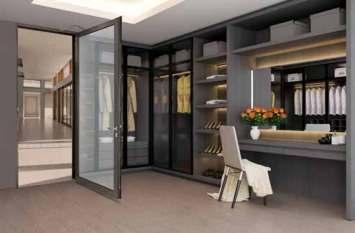
product is eroding. Third, people have started spending more on their homes, and they are looking for better-quality products. This has led (perceived) to a shift in demand from uPVC to system aluminium.
The answer is no.The uPVC market is still growing at a healthy rate of over 20% year-on-year. The market has yet not peaked up to its potential (around 2025% market share) and therefore there is enough room for the uPVC products to grow. The industry will become more competitive and therefore new ways, new markets and innovations will help the industry grow further.
Quality will play a very vital role in the sustenance and expect in the next decade there will be consolidation, merger, and clear demarcation of products by their type of performance. Energy, sustainability, and green will play vital roles in the selection of newer materials or usage in specific segments. Thermal break in aluminium for better performance will see introduction and usage in the industry. Therefore, uPVC should become a preferred product in
residential segments and thermal break aluminium mostly for commercial and façade applications.
The uPVC window industry has a larger perspective than just competing with system aluminium. It must cater to the diverse and evolving needs of customers, who are looking for more than just windows. They are looking for solutions that enhance their comfort, security, and lifestyle. They are looking for products that are customized, smart, and ecofriendly. They are looking for brands that arereliable,trustworthy,andinnovative.
The uPVC window industry should rise to these challenges and
opportunities, and deliver value to the customers. It should leverage its strengths, such as cost-effectiveness, versatility, and functionality, and overcome its weaknesses, such as lack of awareness, standardization, and differentiation. Investment in research and development, quality control, and customer service should help the industry to create the much-needed differentiation. It must collaborate with other stakeholders, such as architects, builders, influencers, and regulators, and create a conducive ecosystem for the growth of the industry.
The uPVC window industry has a bright future ahead if it can adapt to the changing market dynamics & customer preferences. Also, It has to embrace innovation, excellence, and sustainability,&createanicheforitselfin the construction industry. It has to offer more than just windows, but a complete solution for the customers’ needs and aspirations.



SHASHIDAR REDDY
Managing Director, Shakti Hormann Pvt. Ltd.
What is the size of the present metal door & fire door market in India?
Termmetaldoorisamostlymisconstrued term for hollow metal doors. It is required to qualify the construction of such doors as they are mostly sandwiched panels with various infill based on application. The market for hollow metal doors is approx. 2000 crores, which is completely factory-finished for receiving appropriate hardware, which is predefined and pre-punched on

the shop floor. The hollow metal door market has been growing steadily across the country as it has found suitable applications in various buildings. It has been in use for more than two decades and is seriously being considered as a better alternative for wood and woodbased doors. Currently, the fire door market has grown close to 600 crores majorly in the specification-driven market. Specimen fire doors have to be tested and certified by the approved

laboratories to confirm their fire rating, which is usually defined in minutes.
What are the driving factors of the metal door & fire door industry?
The durability and strength of steel are the main reasons for the growth of the steel door industry. Fire doors are a statutoryrequirementasperthebuilding code for all high-rise buildings and factorieswherefirecompartmentationis amust.Thoughfiredoorsareavailablein different materials, the use of steel as a primarymaterialforfiredoorshasgained maximum application. For wooden fire doors, the challenge has been with the material and its availability, it is difficult to compare the performance of two wooden fire doors to be the same, because of the nature of the material and its composition. You may also note that the industry is always looking for products and materials which can be environmentally friendly and contribute to the green building requirement. Also, the push towards non-wood/green products has created a larger awareness andacceptanceofsteelasanalternative.

Discover how to match esthetics with functionality. With its zip blinds, RENSON ® has developed the first external sun screen in the world that was truly wind-tight.
• Upto 12 degree reduction in indoor temperature.
• Upto 35% reduction in Air conditioning tonnage.
• 100 % retractable, motorized, BMS controlled
• Wind-tight up to 130 km/h thanks to ingenious zip system
• For glass surfaces up to 22 m² (width up to 6 m and height up to 6 m)
• No glare inside, no disturbing reflection in television or computer screens
•Insect-proof in closed position
•Available in Mosquito mesh fabric as well
Kendre Makarand | Area Sales Manager India Mob: +91 98 22 912 403 india@renson.eu www.renson.eu

What are the evolutions in metal door & fire door technologies and materials?
The steel door industry has evolved and has come a long way in not only offering various types of fire doors but also quality finishes to match the interiors of buildings. Earlier a fire door was very difficult to operate as they were heavy and most of the time, the openings are not used for daily man operations. Today the fire doors are elegant and factory-finished to meet any project requirement. The semiautomated CNC machines and the technology of forming steel doors and frames have made the entire manufacturing process consistent and the margins of dimensional errors are less than 1mm. Secondly, when you use various types of hardware on doors, it has to be prepped to receive this hardware with absolute precision, dead-on in the slots provided with machine screws.This also saves a lot of time on installation at the site as every component is pre-defined and prepunchedbeforeitisshippedtothesite.
There is also development in terms of glass and glazing being used on steel fire doors, for better light transmission and transparency. The use of fire glass has enhanced the aesthetics of steel

fire doors and newer technologies and materials allow architects to create safer spaces without compromising on design elements.
What is your forecast for the industry for the next seven years, that is for 2030?
We expect the industry to grow at an annual compounded rate of at least 1015%.Theuseofsteeldoorsandfiredoors hasbeenlimitedtocommercialproperties and factories in the past and recently it has found traction in the residential segment. We see maximum growth in the residential segment as steel doors are not available in laminated and wood finishes. This has given an opportunity to builders and individual house owners to try and explore the most durable products in the entrances and internal bedroom application. The industry has already seen some big names venturing into this segment as the potential future for the growing steel door industry.There isalotofmisconceptionwhenitcomesto steeldoorsintheinteriorsofthebuilding, however, if you see a quality steel door it is difficult to differentiate the product and the majority of the time people fail to identify the material as steel. One simple example of these doors used in classrooms shows, how the product is safe and even a child can operate with absolute ease. Next time when you open thedoor,pleasedocheckthematerial-it couldbeasteeldoorandyoumaynotbe abletomakeit.


LT COL SHAILESH PATHAK CEO, Art-N-Glass Inc., Chairman, Chandigarh Chapter of IGBC (Indian Green Building Council), Past Chairman, CII HP State Council
What is the size of the present façade &fenestrationmarketinIndia?
I am not sure of the statistics but this is a huge market and growing at a rapid rate. As per the IMARC group report it was approx. 22,000 crores in 2022. So, with a conservative growth rate of 5% - 6%, it should be around 24,000 crores(approx.). Government projects and commercial projects have taken a new impetus, as well as residential projects in tier 2 and tier 3 cities have taken a big jump in this field.
What are the driving factors of the façade&fenestrationindustry?
Govt of India’s focus on infrastructure projects, road infrastructure, automotive infrastructure like metro and railways, sports infrastructure like stadiums and grounds, construction of new airports and airfields along with renovation and upgradation of
old airports has driven this industry to great heights.
Increased GDP and positive market sentiments, all are signs of a robust economy. This, fuelled by the middleclass growth story, resulted in an increased demand for housing. So, there is a requirement for products related to façadeandfenestration.
Pre-engineered buildings and prefabricated buildings along with precast buildings have given a new twist tothisrequirement.
Earlier our approach was very conventional but now our market has progressed towards world-class products andsolutions.



What are the evolutions in façade & fenestration technologies and materials? How do you envision the façadesof2050?
I visualised more interactive and dynamic buildings which would follow the nature and weather conditions in the coming few decades or say 2050. Through these evolutions in the fenestration technologies and façade material are multi-dimensional and need long discussionsandexplanations.
Evolutions in façade is crystal ball gazing but here I want to give you a few catchwords and phrases, which we all understand. In my view following trends are more likely to be popular in future, which can be classified into four categories:
• Dynamicshadingfaçades
• To control the sunlight for thermal comfort, daylighting and cost-savingonAC.
• Chromogenicfaçades
• Electrochromic glazing, Thermochromic glazing & photochromic glazing using LCD & PDLC technologies.
• Solaractivefaçade
• BIPV, Phase changing materials, greenfaçade,
• Activeventilativefaçades
• Actively ventilated closed cavity
façades and automated operable windows.
If we discuss a few unique technologies, theyareenumeratedbelow:
• Kineticfaçade
• Smogneutralisingfaçade
• ETFE(Teflon)façade(WaterCube StadiuminBeijing)
• Waterflowglazingsystem
• Bionicfaçade
• CortenSteelfaçade
• Greenwallfaçade
• Fibre-reinforcedmaterialfaçade
What is your forecast for the industry for the next seven years, that is for 2030?
In my opinion, it will grow around 10 to 12 %, especially in the commercial and institutional sectors. In the residential sector, growth will be normal approx. 6-8%. But being a creative field, more innovative products, smart and futuristic products will become popular. More emphasisontheenvironment,soenergyefficient and green products will become commonthings.


FMC 370 machining centres with 4 controlled axes have been designed to carry out drilling and milling operations on aluminium or steel profiles. It can be fitted with the X FLOW (Fom Industrie patent) allowing automatic adjustment and optimisation of tool lubrication flow direction. The following functions can also be activated: ”machining with interpolating axes” (3D Custom Milling Module), ”multi-piece machining”, “XPAL” and “multi-piece pendular machining”.



The FMC 230 machining centre with 4 controlled axes has been designed to carry out drilling and milling operations on aluminium or steel profiles. The standard 10 location automatic tool change and tool-free vice jaws adjustment speed up the manufacturing process.





SUHEL KACHWALA Managing Director, FG Glass

TARIQ
KACHWALA Director, FG Glass
What is the size of the present architectural glass market globally and in India?
Suhel Kachwala: The global market for performance glass used in the façade and fenestration industry is expected to grow by a good value and roughly the market is projected to grow at a CAGR of 4.8% from 2023 to 2032.
Tariq Kachwala: The growth of the Indian architectural glass market is estimated to be around CAGR 7.5% for 2023-2027.
What are the driving factors of the architectural glass industry?
Suhel Kachwala: The increasing demand for energy-efficient buildings is a major driver of the growth of the performance glass market. Performance glass can help to reduce energy consumption by up to 50% by controlling heat gain and loss. Additionally, performance glass can improve the thermal comfort of buildings, which can lead to increased productivity and reduced absenteeism.
The growing popularity of smart glass is another factor that is driving the growth of the market. Smart glass can change its opacity or tint in response to external stimuli, such as sunlight or temperature. This can help to reduce glare, improve privacy, and save energy.
Tariq Kachwala: The growth of the architectural glass industry is driven by several factors, including:
• Growing construction industry: Rapidurbanisation,risingdisposable incomes,andgovernmentinitiatives are boosting residential and commercial construction, leading to increased demand for architectural glass.
• Increased awareness of energy efficiency: Sustainable construction practices are gaining traction, driving demand for energy-efficientglasssolutionslike low-emissivity and solar control glass.
• Evolving design trends: Architects are increasingly incorporating glass into their designs for its aesthetic and functional benefits, further increasing its demand.
• Government support: Government initiatives like “Make in India” and “Smart Cities Mission”are promoting domestic glass production and creating favourable conditions for market growth.
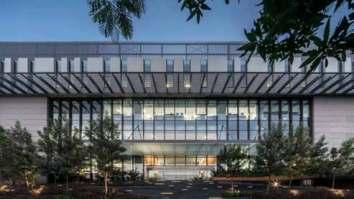

What are the Technological Evolutions inthearchitecturalglassindustry?
Tariq Kachwala: The architectural glass industry is undergoing several technological advancements, including:
• Bird-friendly glass: A high-rise building with bird-friendly glass can help to avoid bird collisions, where we can prevent all natural things saved for a better future.
• Smart glass: Glass that can change its properties (opacity, solar control) basedonexternalstimulilikelightand heat.
• Self-cleaning glass: Glass with coatings that repel dirt and water, reducing maintenancerequirements.
• BIPV (Building Integrated Photovoltaics):Glassintegratedwith solar cells to generate electricity.
• Biomimetic glass: Glass with selfhealing properties inspired by nature.
• Nanotechnology: Nanotechnology is being used to develop new glass materials with enhanced properties like strength, durability, and thermal insulation.
Howdoyouenvisionthefuturemarket for performance glass? What are the factors influencing the growth of the performanceglassmarket?
Suhel Kachwala: The growth of the performance glass market is expected to continue in the next decade, with a CAGR of 4.3% from 2033 to 2043.
The increasing demand for sustainable buildings is expected to drive the growth of the market. Performance glass is a key component of sustainable buildings, as it can help to reduce energy consumption and improve the environmental performance of buildings.

The development of new and innovative performance glass technologies is also expected to drive the growth of the market.These new technologies include self-cleaningglass,self-healingglass,and biomimetic glass.
In addition to the factors mentioned above, the following trends are also expected to drive the growth of the performance glass market in the next 10 years:
• The increasing urbanisation: The world’s population is expected to reach 9.7 billion by 2050, with most of the growth occurring in urban areas. This will lead to an increase in the demand for new buildings, which will in turn drive the demand for performance glass.
• The growing awareness of the health and environmental benefits of performance glass: Performance glass can help to improve indoor air quality, reduce noise pollution, and blockharmfulUVrays.Thisisleading to an increase in awareness of the health and environmental benefits of performance glass, which is driving demand for these products.
• The increasing affordability of performance glass: The cost of performance glass has been declining in recent years, making it more affordable for a wider range of consumers. This is expected to continue to drive the growth of the market.
• The future market for performance glass is very promising. The increasing demand for energy-
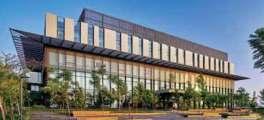

• efficient and sustainable buildings, the growing popularity of smart glass, and the development of new and innovative performance glass technologies are all expected to drive the growth of the market in the next 10 years.
What is your forecast for the industry for the next seven years, that is for 2030?
TariqKachwala: Basedoncurrenttrends and expert opinions, the architectural glass industry is expected to continue to grow steadily in the coming years. The market value is expected to grow by 2030 with a CAGR of 7-8%. Key trends driving this growth include:
• Increasing demand for highperformance glass (energy-efficient, soundproof, etc.).
• Growing adoption of smart glass and other innovative technologies.
• Rising popularity of sustainable building practices, driving demand for green glass solutions.
• Increasing government support for the glass industry.
What are the evolutions in architectural/performance glass technologies? How do you envision the glass façades of 2050?
TariqKachwala: Basedoncurrenttrends and technological advancements, we envision the glass façades of 2050 to be:
• Highly integrated and intelligent: Glass façades will seamlessly integrate sensors, displays, and

other technologies, enabling them toreacttoenvironmentalconditions and user preferences.
• Sustainable and energy-efficient: Glass will be a key component of energy-neutral and even energypositive buildings, generating their own energy through solar cells and other technologies.
• Bio-inspired and self-healing: Glass façades will be inspired by nature, with self-cleaning and self-healing capabilities.
• Personalised and interactive: Glass will be used to create personalised and interactive experiences for users, such as adjusting lighting and temperature based on individual preferences.

Our pledge to achieve carbon neutrality by 2050 is deeply embedded in our extensive track record of minimising environmental impact. This commitment is intricately connected to our aspiration to furnish customers with effective solutions for their own decarbonization journey, thereby assisting them in diminishing their environmental footprint. Our pursuit of net zero carbon emissions stands as a tangible expression of our overarching purpose: to contribute to the betterment of the world.








SHAILESH RANJAN
Business Head – Institutional Sales, Asahi India Glass Ltd (AIS)
What is the size of the present architecturalglassmarketinIndia?
The Indian glass market is evaluated at around INR 125 billion in FY 22 and is projected to expand at a CAGR of 6-6.5% through FY 2028. Growth in the Indian glass market is majorly driven by the growth of value-added products which cover high-performance glasses and other specialised glasses which
help in achieving sustainability through their functional properties. The growth of coated glass in India is largely led by the domestic players because of the obvious advantage of supply through local players to save on fuel and carbon emissions.While the major driving factor for the glass industry is high-performance glass, the concern is that this consists of a very small share of the overall glass market. Coated glass is only 13-15% of the total glass market which in other developed countries is around 40-45%. The major share of the façade industry is still using non-performance glasses like clear and tinted glass which makes a building highly energy inefficient. In the glass value chain, apart from glass manufacturers, processors also play an important role. The availability of the processorsinthemarketensurestheuse of safety and security glasses. Currently, we have around 400 processors, but very few of them are certified by BIS which is an issue of concern. The Indian flat glass market in the value-added glass segment is projected to register a CAGR of over 8.5% during the forecast period.
What are the driving factors of the architectural glass industry?
Some of the driving factors of the architectural glass industry are:
• The growth of the construction and infrastructure sector in India has picked up the pace and is growing at the rate of 7 to 7.5% CAGR up to 2028. This has led to an increase in the demand for glass
• More stringent building by-laws and green building norms along with government support via subsidies as discounts & in Floor Area Ratio (FAR) for green and sustainable projects hasledtofurtheradoptionofglass
• The understanding of how glass is a versatilematerialwitheasyandearly installation can save cost and time is helping the industry to opt for higher glass consumption
• The Industry understands good payback periods with energy savings through glass as recurring savings till the lifetime of the building
• Industries are realising the need for the well-being of occupants for


better productivity in commercial buildings via natural daylight provided by glass and the energy savings that come along with it
• In the evolution of design trends in modern architecture, glass helps architects create visually appealing structureswithenhancedaesthetics, allowing natural light, and creating open, spacious environments.
• Glass being a sustainable material, it is now being sought as the best material to make buildings more liveable
• With the advent of advanced technologies in the glass industry, coated glass has become more advanced and at the same time more affordable.
• Over the short term, increasing demand from the construction industry and growing demand for electronic displays are major factors driving the growth of the market studied.
• However, the increasing cost of raw materials is a key factor anticipated to restrain the growth of the target industryovertheforecastperiod.
• 100% foreign direct investment in the construction industry in India under automatic route is permitted in completed projects for operations and management of townships, malls/shopping complexes, and business constructions.
• By 2025, the Indian construction market output is expected to grow, on average, by 7.1% each year. The real estate industry in India is expected to reach USD 1 trillion by 2030.
• ICRA estimates that Indian firms are expected to raise INR 3.5 trillion (USD 48 billion) through infrastructure and real estate investment trusts in 2022, compared with raised funds worth USD 29 billion.
• AccordingtotheIBEF,Inthefirsthalf of 2022, office absorption in the top seven cities stood at 27.20 million sq.ft.betweenJuly2021-September 2021, and a total of 55,907 new housing units were sold in the eight
micro markets in India (59% YoY growth).
• As per the IBEF, the market size of Indian real estate for the forecast year 2030 (F) is valued at USD 1,000 billion.
What are the evolutions in Architectural / Performance Glass technologies? How do you envision the glass façades of 2050?
Predicting specific changes in façade and fenestration design by 2050 is speculative. Still, there are several trends and potential developments in architecture and construction that may influence these aspects of building design in the coming decades:
• Sustainable&Energy-EfficientDesign: Advanced materials & technologies, such as smart windows, energyefficient glass, dynamic shading systems, and improved insulation, may become standard features to reduce energy consumption and greenhousegasemissions.
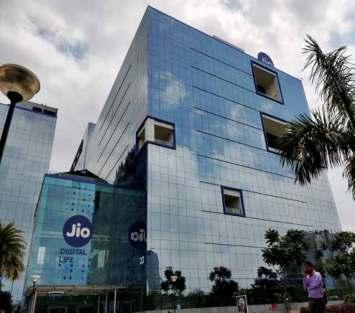
• Integration of Renewable Energy: Building-integrated Photovoltaics (BIPV) could be seamlessly integrated intothefaçade’sdesign.
• Smart Façades: Façades might become more intelligent, using sensors and automation to respond to environmental conditions. Smart fenestration systems could adjust in real-timetooptimizenaturallighting, ventilation,andtemperaturecontrol.
• Adaptive Design: Adaptive façades could adjust their appearance and performance based on external factors. This might include changing colours, patterns, or transparency levels to respond to weather conditions, lighting, or user preferences.
• Biophilic Design: Façades may incorporate more biophilic design elements to connect occupants with nature. Green walls, vertical gardens, and façades designed to support biodiversity could become more common.
• Advanced Materials and Technologies: The development of new materials, such as transparent wood, graphene, and self-healing materials, could lead to innovative façade designs. Other than that technologies like 3D printing can designcustomisedfaçades.
At AIS, we are actively engaged in conducting various research and studies aimed at influencing market practices in specifying the most suitable products based on thorough building and climate analyses. One of our ongoing initiatives involves a comprehensive climate study, focusing specifically on the tropical climate in India and the corresponding performancevaluesofglass.
This climate study is designed to provide valuable insights for specifiers, helping them comprehend the significance of performancevaluesandhowtoeffectively optimise them based on distinct climatic zones. Additionally, the study considers
various Window-to-Wall Ratios (WWRs) across different building typologies. The goal is to empower specifiers with the knowledge and tools necessary to make informed decisions about glass selection, ensuring optimal performance in diverse environmentalconditions.
By delving into the nuances of the Indian tropical climate and correlating these findings with the performance metrics of glass, we can contribute to a more informed and efficient approach to buildingdesign.Ourresearchendeavours ultimately seek to enhance the overall understanding of how glass performs in specific climates and under varying architectural parameters, facilitating the creation of sustainable and energyefficient structures tailored to the unique demandsofdifferentregionsandbuilding types.
What is your forecast for the industry for the next seven years, that is for 2030?
There is a scenario shift in the industry, where people are getting more aware of green buildings and the importance of sustainable materials in building construction.
• New amends are being brought up by building codes, and green building organisations to spread the concept of sustainability to local tier 2and3cities.
• Now this shift is positive as it will ensureadequateglassproductstobe specified for a major chunk of urban fabric. It will also be an initiative for this industry to become more organised.
• The Indian glass industry’s growth has been driven primarily by the constructionsector.Theconstruction and infrastructure industry holds the highest market share in the Indian flat glass market due to the growing demand for flat glass in residential buildingprojects.
• Annealed glass is used in the windowsofbuildings.InIndia,several green buildings or LEED buildings focus on reducing carbon footprint invariousways.Oneofwhichisusing performance glass to access natural daylight.
• According to Green Building Information Gateway, the residential complex DLF Camellias in Gurugram is India’s largest LEED-certified green building with a size of 4.7 million squarefeetasofApril2021.
• According to the Department for Promotion of Industry and Internal Trade (India), the proposed investment value in the glass sector in India for the fiscal year 2021 amounted to INR 57.12 billion (~USD 0.77billion)ascomparedtothefiscal year2020withtheproposedamount ofINR5.67billion(~USD0.08billion).


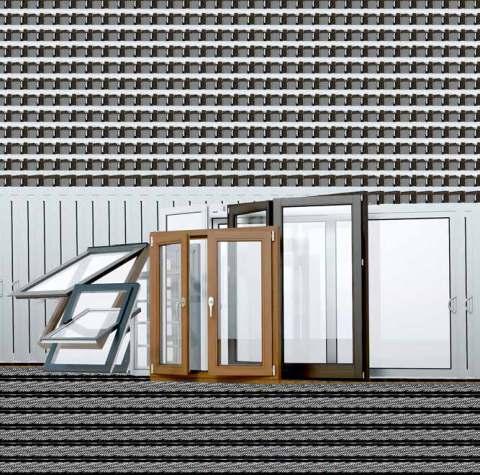




AVANISH SINGH VISEN Director & CEO, ENCRAFT India Pvt. Ltd. (Part of DCJ Group)
Whatisthesizeofthepresentfaçade, door&windowmarketinIndia?
As of the latest estimates, the façade, door, & window market in India boasts a substantialsize,reachingintothebillions of dollars. This dynamic market reflects the country’s thriving construction sector,drivenbyurbanization,increasing real estate activities, and a growing demand for modern infrastructure. The size of this market is indicative of the



significant investment and development in the construction industry, showcasing a robust demand for innovative and aesthetically pleasing façade, door, and window solutions across residential, commercial, and industrial sectors throughout the country.
What are the driving factors of the façadeandfenestrationindustry?
The façade and fenestration industry is propelled by several key factors. Urbanisation is a primary driver, with the burgeoning need for infrastructure and commercial spaces. Rising construction activities, both residential and commercial, contribute significantly. Increased awareness and demand for energy-efficient solutions propel the
industry towards sustainable practices. Architectural trends emphasising aesthetic appeal and innovative designs also fuel market growth. Additionally, a focus on improving thermal and acoustic insulation,coupledwithadvancementsin material technologies, further drives the evolution of the façade and fenestration industry in response to the dynamic demands of modern construction and designpreferences.
What are the evolutions in façade, door & window technologies and materials? How do you envision the facades and fenestrations of 2050 in termsoftechnologiesandmaterials? Evolution in façade, door, and window technologies involves smart materials,

energy-efficient glass, and digital integration. Innovations in sustainable materials enhance environmental performance. Envisioning 2050, facades and fenestrations are likely to
incorporate cutting-edge technologies such as self-healing materials, responsive facades adapting to weather conditions, and advanced energycapturing systems. Smart glass with dynamic transparency and integrated sensors could be commonplace. Ecofriendly and recyclable materials might dominate, aligning with a heightened emphasis on sustainable construction. The futuristic landscape may showcase structures that seamlessly blend technology, aesthetics, and sustainability, redefining the standards of architectural excellence.
What is your forecast for the façade andfenestrationindustryfor2030?
The forecast for the façade and fenestration industry until 2030 is highly optimistic. Anticipated robust growth is driven by urbanization, a surge in construction projects, and a heightened focus on sustainability. Technological advancements, including smart materials and energy-efficient solutions, will reshape the industry landscape. Increased demand for innovative designs, coupled with a growing awareness of environmental impact, will drive the adoption of ecofriendly materials.The industry is poised for transformative shifts, meeting the

evolving needs of modern architecture. Overall, the next seven years hold exciting prospects for the façade and fenestration sector, marking a period of significant expansion and innovation.
Itcanbeconcludedthatthetrendscollectivelyshowcaseashifttowardsmoresustainable,technicallyadvanced,andaesthetically diverse facade and fenestration designs in the Indian market.This sector’s evolution continues to be shaped by a balance between aesthetics and technology.
Sustainabilityisgoingtobethebuzzinthecomingdecade.Mostprojectswouldseekgreen-certifiedproducts.Thisdecadewillbe witnessing some outstanding and excellent out-of-the-box material finishes, which will be introduced to the market.The future of this industry will be safe if it maintains and safeguards the standards for the products.
Due to the growing environmental concerns, several measures are being undertaken by the government of India (GoI) to promote the use of sustainable construction materials and minimise carbon emissions. Along with the advent of technology and awareness, there is a demand for high-quality facades that regulate temperature, protect against rain, and resist corrosion to ensure comfortable and durable buildings on account of changing climatic conditions like heat, humidity, and monsoon is strengthening the growth of the market.
Based on the comments from all the industry leaders and reports, we can come to an inference that the Indian Window, door, and façade market would vroom again if the manufacturers stress maintaining quality, testing, and certification while advancing technologies including digitalization and sticking to sustainability priorities.

“Crafting Innovation, Unveiling Distinction – Aludecor is ready with its honeycomb aluminium panels for the new age architects. From real estate to the transport industry, NexComb– as Aludecor has named these panels - is a revolutionary force in architecture, transcending industries; impacting aviation, automotive, manufacturing, & renewable energy. Lightweight & robust, NexComb redefines design possibilities and contributes to ecofriendly solutions, revolutionizing various sectors across the globe. And there’s more to the story, Aludecor is the exclusive ACP manufacturerinIndiathathasthein-house honeycombcoreproductionfacility”
NEXCOMB-HONEYCOMBALUMINIUM PANELS
Imaginethedynamicswherearchitecture becomesanartofsecrets,wherestrength whispers tales of resilience, versatility is weaved in every pattern, and aesthetic appealistheenigmathatcaptivatesevery gaze.
Well, before you eye roll and call it “too much”, let us introduce the newest
NexComb, the honeycomb aluminium panels, is the harbinger of a design revolution, ready to be the protagonist in a story that transcends boundaries. As the urban landscape transforms, NexComb emerges as the linchpin redefining possibilities, leveraging form and functionality. Brace yourself for a design journey where innovation meets urban flair, and NexCombtakes centre stage in shaping the future of architectural narratives!
Inspired by the intricate honeycombs found in nature, the genesis of this groundbreaking idea led architects and engineers to replicate nature’s strength and efficiency in man-made materials. Datingbackover3,000years,thehistory of aluminium honeycomb panels can be traced to ancient Greece, where the hexagonal shape, noted for its efficient use of space, gained recognition. The Pantheon in Rome showcased early honeycomb structures, & by the 1600s, Galileo & Robert Hooke explored the properties of hollow solids. In 1859, Charles Darwin praised the perfection of hive-bee combs in economizing labour and wax. Honeycomb production techniques were established by 1901, with Hugo Junkers patenting honeycomb cores in 1915 for aircraft.
Like in every step of its 22-year journey, Aludecor has a standout feature for its honeycomb aluminium panels (NexComb)aswell.
At the heart of NexComb lies Nexcore, a technological marvel developed by Aludecor. This honeycomb core sets


Aludecor apart as the first and only ACP manufacturing company in India to produce honeycomb core. What makes Nexcore truly exceptional is its ability to strike a balance between lightweight construction and high strength, a combination that has become the cornerstone of modern architectural design. As the only company in India to produce such a revolutionary core, Aludecor has positioned itself at the forefront of pioneering innovation in the claddingindustry.
NexComb is not merely a product; it is a testament to Aludecor’s commitment to providing architects and builders with cutting-edge solutions that go beyond conventionalboundaries.
NexComb boasts impressive compressive and tensile strength. NexComb sets itself apart with its outstanding compressive and tensile strength, establishing a benchmark for structural integrity and reliabilityacrossvariousapplications.
The advanced mechanized glue spreader contributes to NexComb’s exceptional peel strength, resulting in a lightweight yetrobustpanel.
Boasting remarkable compressive and tensile strength, NexComb panels range from 6mm to 100mm, providing architects and designers the flexibility to embark on new-age design ventures.
Customizable in Aluminium, Zinc, and StainlessSteel
Harness the adaptability of NexComb as it can be tailored in a variety of materials, including aluminium alloys, Zinc, and stainless steel, providing a versatile solution for diverse project requirements.
in Colour: In-House Coil Coating Offers Huge Potential for
Take control of the aesthetic narrative with Aludecor’s in-house coil coating line, allowing for precise customization
of NexComb panels in a rich spectrum of colours and shades. This is a huge bonus for all the architects and design consultants who wishes to make their project stand out from the crowd.
Assurance: Aludecor Certified for FireRetardantCore
Trust in NexComb’s technological sophistication as Aludecor stands as the sole certified Indian company with the expertise to manufacture fireretardant cores, ensuring an elevated standard of safety in construction projects.
With a state-of-the-art manufacturing base and an internationally acclaimed research and development team, NexComb emerges as one of the most advanced offerings in the cladding industry, exemplifying Aludecor’s commitment to innovation and excellence.
NexComb by Aludecor is a structurally powerful and sustainable aluminium honeycomb panel. It embodies environmental consciousness by using recyclable materials and aligning with global sustainability goals. Aludecor’s legacyisrootedingivingbacktotheEarth, ensuring progress and sustainability go hand in hand. With NexComb, Aludecor remains a trusted leader in the cladding industry, shaping the architectural landscape and inspiring a future of ground-breakingmaterialswithapositive impact.
For more details on the product, contact:

Aludecor
Email: info@nexcomb.com
Website: www.nexcomb.com
Toll-free: 18001020407
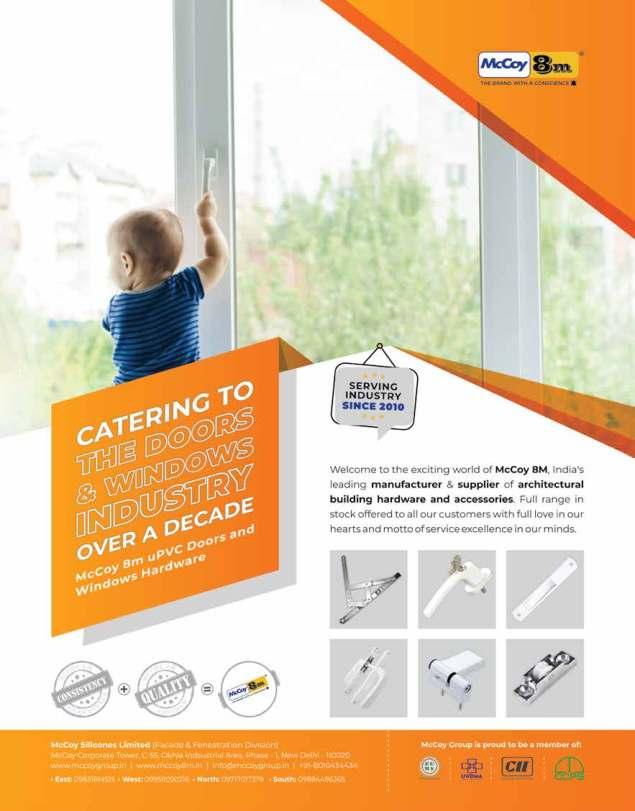


“Sustainability is Not Just About Getting Some Rating. It’s About Following a Set of Principles”

AR. KIRAN KAPADIA
Founder, Kapadia Associates

Kiran Kapadia, an architect and urban designer, is the founder of Kapadia Associates. He received his Bachelor’s degree from CEPT University, AhmedabadandMasterofArchitecture in Urban Design from Harvard University, USA. He founded Kapadia Associates in 1991, which has grown steadily over the years to become one of India’s leading architectural firms with a strength of 130 people. Kapadia Associates is involved in a wide range of projects and has won numerous professionalawards.
Ar. Kapadia is actively involved in academics and has served as visiting faculty at various architectural institutions in the country including CEPT, Kamla Raheja Institute of Architecture and Academy of Architecture,Mumbai.Hehasalsobeen
a member of the Academic Council at the School of Environment and Architecture(SEA),Mumbai.
Ar. Kapadia, a passionate runner, has earnedthecovetedSixStarMedalin2021, given to runners who have completed the six World Marathon Majors which include Tokyo, Boston, London, Berlin, Chicago and NewYork. He has qualified andrantheprestigiousBostonmarathon for3consecutiveyearsfrom2021to23.
In an intriguing interview, Ar. Kiran Kapadia spoke toWFM Media about his design firm Kapadia Associates, various projects completed by the design firm over the past 30 years, his ongoing projects, challenges he faced on his journey as an architect, his definition of sustainability and principles for design, andmuchmore.


Could you please tell us about your company and how did you enter the fieldofArchitecture?
I’m an architect and I did my bachelor’s program at the School of Architecture (Centre for Environmental Planning and Technology, CEPT) in Ahmedabad. I am fortunatetohavetheopportunitytostudy under the masters like Ar. Anant Raje and Ar.B.V.Doshi.Thiswasinthelateseventies and the early eighties. After completing my Bachelor’s degree in Architecture in 1984, I worked in Mumbai for a couple of years with a firm called Architects Combine. It was a very prominent firm at that time under Ar. Kamu Iyer, who is no more. In 1986, I decided to go abroad to the United States to pursue my Masters in Urban Design, and completed it at HarvardUniversityattheGraduateSchool ofDesign,Harvard(1986to88).
After working with a few renowned architectural firms for three years, in 1991 I came back to Mumbai and started my own practice Kapadia Associates. Now we’re about a little over 30 years old.

Started as a very small one-man practice, over the years, we have developed into a full-fledged architectural firm, doing a wide range of projects. Today, we are a medium to large-size firm in the city with over130people.Wecurrentlyhaveoffices inMumbaiandPune.
Please tell us about the transition in architectureoverthelast30years.
As a young architect in those days, that’s in the late 1980s, there were not many choices as far as careers were concerned, unlike today’s youngsters. The options were limited to commerce, science, engineering or medicine depending on one’s interest. I was more inclined towards engineering with a
kind of creative bent. One of the few professions that you considered was architecture, therefore I decided to apply for graduation at the School of Architecture, Ahmedabad (CEPT) and got through. It became a very different story then onwards. CEPT was a small but leading school then. Ahmedabad not only had a very strong pedigree of Louis Khan and Le Corbusier projects butalsopeoplelikeB.V.Doshi,whowere responsibleforsettinguptheschool.Ar. Doshi was teaching very actively, and a lot of the younger faculty members had been working with him. So it was a kind of very inspirational environment. At CEPT, I got immersed in architecture… I ate, drank, and slept architecture literally. Those were the formative years where I learned the nuts and bolts of architecture, both design and technical aspects. I owe a lot to this step down the path actually to reach where I am today in terms of my background.
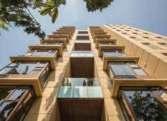
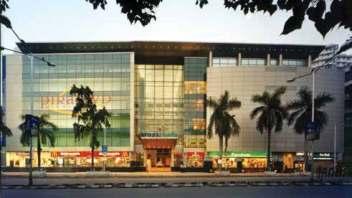














I still see the influence of Doshi and LouisKhaninyourprojects.Isittrue?
Yeah. Influence of Doshi, of course. The CEPT campus itself is quite inspirational beingdesignedbyDoshi.Andtheninthe neighbourhood,thereareotherbuildings designed by Doshi and Louis Khan, and the IIM Ahmedabad campus is not very far away. At CEPT, one is surrounded by the masterpieces designed by these masterminds, learning happens not just from books. So these were the distinct formative experiences, very unique for me as an architect.
Could you please tell us about some oftheturningpointsinyourlife?
I came back to Mumbai from the United States in 1991 and started the practice. Like any other young practice, we didn’t have too many projects.We started with small projects like small residences for friends and families. Since there was enoughtimeavailableintheinitialyears, I taught architecture in some schools like Kamla Raheja Vidyanidhi Institute of Architecture and Environmental Studies (KRVIA), Mumbai for a couple of years as a visiting faculty. Gradually we progressed and built several projects and our projects were published in differentmagazines.Thesizeoftheteam increased.
The early 90s was also the time of the economic boom with reforms by then finance minister Mr. Manmohan Singh. The Indian economy opened up, and the projects became bigger and more complex. Foreign direct investment was allowed, a lot of foreign investment came in, and foreign companies came in as investors. As a result of Manmohan Singh’s trading policies, the economy of the country was booming, and all professions had to gear up to meet the

demands. I was at the right time and at the right place. My practice gradually progressed. But one of the biggest breakthroughs for us was a public project. Earlier we were doing small projects like office building, residences, interior design, etc. We designed India’s first mall, Crossroads at Tardeo It was an interesting task. It was a pharmaceutical factory, which was retrofitted into a mall. The client had appointed a very well-known architect from Singapore called DP Architects. The owners, Piramal Pharmaceuticals wanted a local architect to help DP architects, and they didn’t want to go in for a very well-known established firm, but a young firm that they could work with, in order to avoid ego clashes. And we were a young firm. People felt that a young practitioner who had studied abroad would be the right kind to work with an established Singapore firm, and that’s how it started.
The second exciting project was CR2 mall at Nariman Point in Mumbai, with the retail down below and parking up above, showcasing many such novel ideas. Both these big projects were for the same client. So these were our first experiences with large public projects.
Newmallswerecomingintothecountry for the first time and were getting more opportunities.We had to grow the office because of these projects. Moreover, not many architects had experience in these kinds of projects. This is called the first mover advantage. This was our first big leap.
Thesecondbigleapwasintheresidential sector, as more and more taller towers were opening up. We designed several large-scale residential projects.
We got our next big break somewhere in the early 2000s when we were asked to design a campus for Hindustan Unilever (HUL) in Andheri, Mumbai We designed the master plan for this large campus. It was on about 16 acres of land in Andheri, and their goal was to consolidate multiple small offices located in and around Mumbai. They had outgrown their main head office at Churchgate, and they wanted to move intooneconsolidatedcampussincethey found it to be far more effective from a managerialperspective.Nowitisareality with the huge campus accommodating a training centre, a hotel of about 90 rooms, a recreational facility for the employees, etc.
By then our office truly became diverse with a large number of projects. We were doing malls, retail projects, large office buildings, etc. Other than Unilever campus, we did a Campus for Thermax in Pune. We also did some work in Bangalore. We did a large number of residential projects, like AshokTowers.



What are the types of projects KAPL specialisesin?
Honestly, we don’t have a speciality in terms of projects. Even today, after 30 long years, we like to do a diverse range of projects.
We do a variety of projects, right from residential projects for Lodhas to very large master planning for Palava City, on a few 1000 acres, out of which only about 20 or 30 per cent has been built so far. We continue to be involved in Palava project even today. So we are doing large-scale urban design at one end, and small residential and office buildings at the other end, and everything in between.
The practice likes the change of scale. As we evolve, we don’t want to be doing thesametypeofprojects.Theprofession has evolved over 30 years. Earlier at one point in time, if you had 25 or 30 people, you were looked at as a large office. And today,25or30wouldnotbealargeoffice. Projects have become much bigger and more complex. Today, a hundredpeople office is not uncommon, but in the nineties when I started, a hundredpeople office was very rare and highly creditable. There are lots of hundredpeople architectural firms today.
Earlier, developers were a kind of very small mom-and-pop shops. Today, many of them have become very large,
and some of them are publicly listed. A few of our main clients including Lodha, and Godrej Properties, are publicly listed companies. So they have their due diligence, and large teams internally working with architects. So, we’ve also had to grow parallelly to meet their requirements. Mumbai city is growing, so are these large integrated developments.
Over some time, as more infrastructure comes in, people will enjoy a better quality of life in integrated townships like Palava City. Here I’m talking about the middle income and lower middle income strata. The township will cater tothesestratabyconsideringschoolsof different kinds, like an IB school at one end to an ICSE school, or an SSC school to CBSE school.The same for healthcare facilities too. We continue to work on such large-scale projects with diversity, along with small-scale projects. So I think this kind of diversity is what keeps us going.
You studied in prestigious institutions which always focused on sustainable developments and sustainable practices. What is your take on sustainable architecture?
Yes, It’s an interesting question. Honestly speaking, sustainability relatively is a new buzzword in India, but, if you look at our traditional architecture, a lot of it was completelysustainable.

Today, sustainable construction has become a kind of a global topic of discussion. As we go for taller buildings, as we build more, carbon footprints become a critical issue. There is no choice, but to become sustainable. Like a lot of developers, other clients have taken calls to say that they will achieve carbon neutrality by a certain date. The Indian government is pushing it a lot. All architects need to practice sustainable design, not necessarily only in terms of rating systems, but in a much deeper sense through passive methods, cross ventilation, etc. Luckily, unlike the West, wedon’thavetodealwiththecold.So,all our buildings are naturally ventilated, but manyarenotlookingatcrossventilation.
Our problem is the other way around. Instead of keeping the cold out, we have to keep the heat out. So, insulation, new materials, technology, lowcarbon concrete, etc. matter. Today, in Europe, people are building sustainable buildings with no carbon input. Even skyscrapers are built with timber. But in India, timber is not a material of choice, unlike in Canada or in the US, where there’s ample timber. In India, we still build with concrete and steel, and companies are looking at low-carbon steel and concrete, and experimentation is going on exploring more sustainable materials. Incorporating sustainability is an effort. Sustainable architecture is not a luxury anymore, but a necessity.
In bulk of our residential projects, what happens today is that a developer completes a project, hands it over to the owner, or somebody who buys the flat, and then their association with the project ends. I think this approach is going to change, and the endusers are going to benefit more, like in office buildings. The buyers are more conscious, and keen to know about the developer’s sustainability goals by measuring performance indexes. We havedifferentkindsofhigh-performance glass available in the market.
Most of the developments are happening in the commercial sector, i.e., in the office buildings. A lot of multinationals are coming in and they want to follow international standards whether their officeisinEurope,AmericaorIndia.They wanttofollowthesamekindofstandards right through in residential. In a project like in Palava, there’s a lot of effort that is going on in terms of not just looking at a building level but also looking at a city level. For example, solar power generation is not just from rooftops, we should be able to harvest solar power at the city level. We also need to look at water conservation, cross ventilation, better quality air, etc.
Certified energy-saving devices by BEE (Bureau of Energy Efficiency), help to save power. Similarly, a lot of innovative things are coming in the sustainability sector, not only in terms of architecture but even in terms of finances. Sustainable finance or green loans are extended to Environmental, Social, and Governance (ESG)compliant development projects, including affordable housing. This also encourages architects to design more sustainable buildings. Everyone in the field is gearing up for the future and nobody wants to be left behind.
You have been seeing the development over so many years in India. Where is India positioned comparedtotheglobalorganizations or developers or offices in achieving sustainability, even at the local level or even in tier 2 or 3 cities, where
Awareness plays a key role. If there is awareness of the benefits of green buildings,it’snotverydifficulttodogreen projects even in tier-two cities. It might take some time to percolate. But I think that there is a greater demand from the end users, and the developers would be indebted to meet their client’s demands. The big developers are doing it because of funding/investments from foreigners who check on the sustainability index andsustainabilitygoals.Thegovernment
of India is pushing sustainability and performance, not only in buildings, but even in equipment used in a very big way. The government is pushing for sustainability because it is a signatory which leads India to be a carbon-neutral country by a certain date.
Our magazine is focused on façade and fenestration. What is your take onthesustainablefaçade?
I think as far as the office buildings are concerned, we need glass and glazing mainly to get light into the office

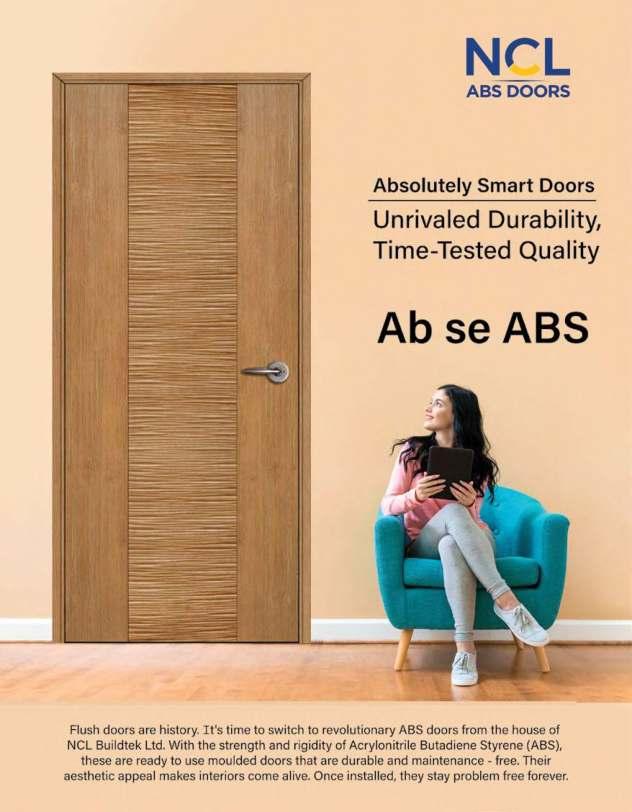
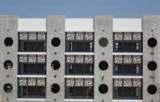

interiors. And today, glass technology in India has developed quite significantly. There is no need to import a lot of the glass. Most of the big manufacturers of glass are already here producing highperformance glass. Shading devices are widelyusedonfaçadesandfenestrations after analysing the sun’s path and other factors. The shading devices regulate heat and light ingress. In India, the problem is twofold. One is that we have ample natural light available throughout the day, which will cut down the use of electricity in terms of lighting.
Secondly, we don’t have too many dark days and our daylight is long. So, to harness daylight, we need to look at innovativetechnologieslikeLighthelves. We have long days, unlike the West. We don’t have a very pronounced winter in thatsensewherethedaysgetshortened.
Here are significant opportunities, and architects and façade engineers work with those opportunities, which is important.
Coming to residential buildings, I get a little bit perturbed when I see big glass façades without any shading devices. In India, we’re generally used to having openablewindowsorwindowsthatallow air to come in. Now, the problem is fixed windows for very tall buildings. Having openable windows on the 40th floor is not the most practical thing to do either. So there are some innovative methods likeventsfixedwiththewindowmullions areoptions,whichwouldallowthebreeze andnaturalventilationtocomein.Thereis more scope for innovations, technologies and developments in these areas looking at geography, climate, weather, etc. At the moment, we’re importing and using products manufactured abroad. But I

think the industry needs to develop local products.
Please tell us about the projects you do.
About 60 to 65 per cent of our projects would be residential. This, we break it up into two types. One is group housing, which is a large complex. Second is individual boutique residential buildings, whichareliketheonesinsouthBombay–smallerluxurioushousingprojects.
The balance of 35% is divided between commercial projects, institutional projects, etc. In the recent past, we have done a fair amount of commercial work including high-quality top-grade office buildings.
Could you please tell us about some of your most challenging projects as wellasyourfavouriteprojects?
I can give you four or five different examples of projects that we loved working on. It’s just because these projectswerechallenging.Thechallenge could be because clients were more demanding or because the site was challenging in terms of conditions.
Vasant Vilas was an interesting project that we did, which is a small luxury residential building. It is a very small residential project that we’ve done in south Mumbai at Babulnath Road -- A nice small 40,000 Sq ft single apartment building. We’ve used a lot of local stone on the façade.
And on the other end of the spectrum, was the Unilever campus, which is a large campus, not tall, because of height restrictions since it is close to the airport. It’s about five stories - ground and five. It is horizontally spread.This was a building for self-use for the client and they were very particular about innovations and sustainability. We not only received the Indian Green Building Council (IGBC) rating, but we also got high ratings from TERI,whichismorestringent.
Another challenging project was one of the first few tall buildings that we didLodha Bellissimo, which is a 48-story building. It has an interesting curved form, because of which the façade design was a challenge. We were very careful about the proportion of the width of the building to its height - the ratio was very important. We needed certain shear walls, flanking walls, etc. It was a big learning experience as a large project.
A residential school for 1000 girls in Gandhi nagar near Ahmedabad for the BAPScommunitywasanotherchallenging andinterestingproject.Itwasacompletely new kind of program and this project was verydiverseandadifferentexperience.

My latest and one of the most favourite projects is Palava. This was our firsthand experience of working on a large city development. We have been at it for the last five to ten years. We’ve seen the city come up, grow, age. Things have changed over time. We started with one typology of housing. People’s expectations have become different. When we started the project, the price was about Rs 2,500 per Sq ft. Today, the price there is Rs 7,000/Sq ft. We continue to be associated with Palava. We are working on a couple of other larger projects within the city, like redeveloping certain older parts of the city.
Some of these lands belong to the government, being redeveloped by developers. A part of it was MAHDA colonies and the rest was part of future city developments.
We’re designing a new campus for a State government technological institute like an IIT to create job skills amongst the youth. Such universities are coming up in the states of Gujarat, Andhra Pradesh, Maharashtra, Madhya Pradesh, etc. In Maharashtra, it’s called MSSU, which is Maharashtra State Skill University. There will be the main campus and then smaller satellite campuses in various places across the state. This university will become a model,percolatedwithsmallerkindsof buildings or smaller campuses across the state.
What is the most preferred material for you for building façades?
Depending on the scale of the project, the context, the site, the location, etc. we choose the façade material. We’ve experimented a lot with many products. We like to work a lot with stone, incorporating stone cladding and stone screens. It is an important element that we find in a lot of our projects, and I think climatically the stone screens are very useful. We’ve experimented with various materials. We’ve done screens in stone, GRC, and contemporarymaterialslikealuminium, metal, etc., which are quite successful.


So I think screens are something that I’ve also found very effective in India because they can cut the glare out. Glare is one of our biggest challenges.
Since ancient times, screens have been used in India quite substantially as an architectural element. With 20 years of practice, we’ve learned to develop them in a more contemporary manner, with newer materials, etc. Operable screens, folding screens, automated screens, etc., are the latest innovations coming through. So I think screens are an element that we are particularly interested in.
Stone is a material that we like to work a lot with. We apply dry cladding and sometimes it’s composite. Otherwise, we use wet cladding. Glass is another material that we like to work with. In several projects, we have used glass.

How do you manage convincing your clients with your ideas, while contractors are always in search of cheaper materials?
It’s difficult, but I think one has to work based on performance-based analysis. We have to ensure the long-term goal. Based on these analyses we need to convince the client. So it’s a battle and not an easy process. Sensibly using materials is important.
Looking at the future, 20 years from now, what kind of progress do you predict in façade technologies, materials, and construction?
The things that I wish to see is, less use of glass and aluminium in the residential sector than in the commercial sector. Well,thecommercialsectorisdeveloping initswayandmayusemorehigh-quality performance glass. They may become affordable by then.

Mybiggerconcerniswiththeresidential sector, where one has to look for more cost-effective and innovative solutions. So I think the façade & fenestration industryneedstouptheanteintermsof their innovations, technologies, etc.
Atthemomentaluminiumhasacottage industrykindofapproach,whereyoubuy the sections, cut and install it. I expect to see a lot more prefabrication coming in, which will ensure higher quality and performance.
We will see innovative sections, which will cut down the amount of aluminium used, also bringing costs within a certain level of control, with better ventilation. Standardisation of doors and windows will happen in all types of fenestrations including sliding windows or casement windows, which are openable. When it comes to buildings, we have no choice but to go tall rather than horizontal, because of the tremendous pressure on land,hencethedemandforpre-fabricated products will increase. Another point is that pre-fabs will increase the speed of construction. Use of prefabricated fenestration, manufactured in a factory, getting it to the site and installation are the kinds of things that we are yet to see in India, I hope to see more factory-built homesinthenext15to20years.
Like cars made at a factory and shipped toyou,façadescanbebuiltatassembling points to ship to the owners. There are


elements like heat, light, acoustics, and corrosion, especially along the coast face very heavy rainfalls. A lot of R&D is required in this.
Now we have different ratings like IGBC, GBC, ECBC, Griha, etc. to decide on the quality of buildings and materials used. Do we have to insist on ratings? As an architect, how do you recommend that? Theclientlooksatitfromtheadvantages that he gets with this kind of rating. If you do certain things, like a checklist of whatneedstobedone,thenirrespective of what rating system you’re going for, you will adhere to that. We need not communicate and convince the client of this idea.
In terms of window wall ratios, we need to consider specifications on the type of windows needed for efficient ventilation, possibility of cross ventilation, allowance of ample natural light coming into spaces

deep inside, etc. So, if you do a checklist allowing passive measures, it is good enough. Orientation of the building has nothing to do with ECBC, GRIHA or IGBC ratings. They don’t tell you how to do it. The bigger corporates, because of their corporatephilosophy,aregoinginforthese ratingsintheresidentialsector,butalotof the smaller guys don’t see any advantage of that. So they’re not even going in for that.Theydon’thavethebandwidthoften people to document each and everything and then submit it to rating agencies/ institutions and they find the task to be a littletediousastheyaresmallfirms.
Sustainability is not just about getting some rating. It’s about following a set of principles. And that’s the philosophy that we try to employ. Sustainability is, incorporating a lot of passive measures looking at ventilation, shading, etc. If we address all these measures, I think your buildings will be sustainable to a great extent.
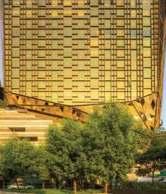


What is your advice to the young and upcomingarchitects?
When we started more than 30 years back, it was a little different because, there were not many institutions teaching architecture, or employment for architects. Now there are many more opportunities, with larger and diverse projects, advancements in technologies, an abundance of materials and complex designs.
As the opportunities are many, the competition is also tough. So it’s a twosided coin. You will have to learn to work in a team, and teamwork becomes very, very critical. You can’t be a prima Madonna on your own today. We believe very strongly in teamwork where differentexpertsarecomingin.Expertise in a specific field is the key. Considering sustainability, some experts use specific software to do various calculations. We work with them and they get equal credit for it.
Today, I think the field of façade design has opened up a lot more as you know. Your magazine is about façade design, which has become a speciality. Façade engineering,forexample,alotofarchitects
are involved in
Rather than being a jack of all trades, find out your interests and strengths, and based on your inclination, you

have to develop a speciality that you think you can pursue and be passionate about. So younger architects must see opportunities in what interests them and pursue that with a passion. I think that’s thekeytoprofessionalgrowth.



Leading global experts in city planning including architect Hafeez Contractor, design firm Sasaki and consultancy firm Buro Happold, are on board for the Dharavi redevelopment project in Mumbai. Led
by Contractor andThe Adani Group, the consortium will also boast experts from Singapore as they plan on rehabilitating the Dharavi slums, home for millions. The contractor has planned many rehabilitation projects and designed some of India’s tallest buildings, including The 42 in Kolkata and The Imperial twin towers in Mumbai.
70-year-old American design firm Sasaki is known for its expertise in creating sustainable, integrated live-work-play environments. Buro Happold, a UK-
based consultancy firm, is known for its creative and environmentally conscious infrastructuresolutions.
The experts from Singapore bring their expertise in creating cutting-edge urban living spaces. The country’s Housing Development Board built over 1.2 million homes and set a global benchmark inequitableurbanhousing.
In 2022, the Adani Group emerged as the winnerwith ₹5,069crorebidtoredevelop Dharavi.

In a bid to revive the iconic Sardar Vallabhbhai Patel (SVP) Cricket Stadium in Gujarat, the Ahmedabad Municipal Corporation (AMC) is contemplating a comprehensive Rs 180 crore redevelopment plan, according to sources familiar with the matter. This stadium holds historical significance as the venue for India’s inaugural international cricket match in 1981.
Designed by the renowned architect Charles Correa, the stadium’s transformation is envisioned to turn it
into a state-of-the-art multi-sport facility capable of hosting international events, including a hopeful bid for the 2036 Olympic Games by India. The proposed redevelopment underscores a strategic move by the civic body to optimise the venue’s potential and bolster India’s standingontheglobalsportsstage.
Despiteitsillustriouspast,theSVPCricket Stadium has faced underutilisation over theyears,promptingtheAMCtoconsider a substantial overhaul. Past efforts to breathe new life into the stadium have
met with limited success, necessitating a more comprehensive and forwardlookingredevelopmentstrategy.
Officialdiscussionsontheredevelopment planarecurrentlyinprogress,withaformal decision pending before the standing committee of the corporation. To ensure awell-informedapproach,thecommittee has requested a detailed report outlining the conservation management plan for theproposedredevelopment.
The ambitious project not only aims to rejuvenate a historic sporting venue but also aligns with the broader vision of creating world-class infrastructure to support India’s aspirations to host major international sporting events. As the city awaits the corporation’s decision, the proposed overhaul holds the promise of transforming the Sardar Vallabhbhai Patel Cricket Stadium into a modern, multi-sport hub that could potentially host global competitions, including the coveted2036OlympicGames.











































In a groundbreaking achievement, Godrej&Boyce,theflagshipcompanyof the Godrej Group, proudly announced that its vertical, Godrej Construction, has successfully erected and operationalized a 500 sq. ft. office within an astonishing timeframeofjust40hours.Thisremarkable feat took place at their greenfield campus locatedinKhalapur.
Dubbed ‘The Cocoon’ owing to its distinctive curved elliptical design, the
office was crafted utilizing prefabricated modules through cutting-edge 3D Construction Printing (3DCP) Technology. The entire structure, from 3Dprintingtoassembly,wascompleted within the remarkably short duration of 40 hours.
The comprehensive scope of the project encompassed the installation of 3D printed modules, civil works, waterproofing, flooring, external and internalpainting,electricalworks,lighting, AC installation, plumbing, drainage and sanitation fixtures, office furniture, and even landscaping – all achieved within thespecified40-hourtimeframe.
What sets ‘The Cocoon’ apart is the environmentally conscious approach
adopted in its construction. The office was built using a concrete mix design that incorporated up to 20% Recycled Concrete Aggregates (RCA). These aggregates were sourced from concrete debris recycled at the Godrej & Boyce RecycledConcretemanufacturingfacility situated inVikhroli, Mumbai.
This sustainable initiative not only demonstrates Godrej Construction’s commitment to innovation & efficiency but also highlights its dedication to ecofriendlypracticesbyincorporatingrecycled materials into the construction process. ‘The Cocoon’serves as a testament to the transformative potential of 3D printing technology in revolutionizing traditional construction methods and fostering sustainabilityintheindustry.
In a harmonious blend of tradition and modernity,thenewintegratedterminal building at Trichy Airport has been unveiled, drawing inspiration from the rich architectural heritage of the region. Valued at Rs 1,000 crore, this terminal, set to be inaugurated by Prime Minister Narendra Modi, stands as a testament to theculturalvibrancyofTrichy.
The architectural marvel takes cues from the monuments in and around Trichy, as well as the cultural significance of festivals like Pongal and rangoli. The iconic form of the building is a nod to the ornamental roof of the ‘gopurams’ in South Indian architecture. Passengers are greeted by a towering structure reminiscent of the Srirangam
Ranganathar temple gopuram, creating a majestic entrance to the airport.
The departure concourse is dominated by a roof design inspired by traditional South Indian architecture, exuding a sense of grandeurandculturalrichness.Everyaspect oftheterminal,fromtheflooringpatternsto columncladding,featurewalls,andsignage design, is steeped in the essence of local arts,culture,andtraditions.
Noteworthy is the terminal’s modular construction, allowing for future expansion or alterations without compromising the existing structure and design integrity. The commitment to sustainability is evident in the adherence to‘GRIHA’standards and the achievement of a four-star rating for

its design, emphasizing the maximization of natural light and the incorporation of renewableenergymeasures.
Designed by the internationally acclaimed architecturalfirmPascall+Watson,theTrichy Airport’s new terminal stands as a shining example of a structure that seamlessly integrates the past with the future. As it opens its doors, the terminal promises not justagatewayfortravelbutaculturaljourney thatcelebratestheessence of Trichy.
















Please use BOLD / CAPITAL LETTERS ONLY
Mr/Ms: .............................................................................................
Designation: ........................................................................................
Company: ...............................
Address 1: Address 2:
GST Reg. No: .......................................................................................


City: .............................................. Pin Code: ........................................................ State: ...........................
Tel: .................................................................................. Fax: .......
Mobile: ............................................................ Email: ........................
Cheque / DD No: ........................................................ Dated: ................................Favouring F & F Media and Publications
Drawn on: ............................................................................................................................................................................Bank
How strongly will you recommend this magazine to someone on a scale of 1 to 10: 1 Year (6 issues) `1200/- 2 Years (12 issues) `2299/- 3 Years (18 issues) `3499/-
Please use bold & capital letters only The mode of payment should be a cheque/demand draft favoring F & F Media & Publications, payable in New Delhi, India Please write your name and address on the back of the cheque/demand draft Orders once placed will not be terminated or transferred Please allow a minium of 4 weeks to process the order
Subscribe to Window & Facade Magazine by completing the form and sending it to F & F Media and Publications, C-55, Okhla Industrial Area, Phase - 1, New Delhi 110 020 T: +91-11-40623356 For further queries write to: support@wfmmedia.com















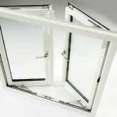


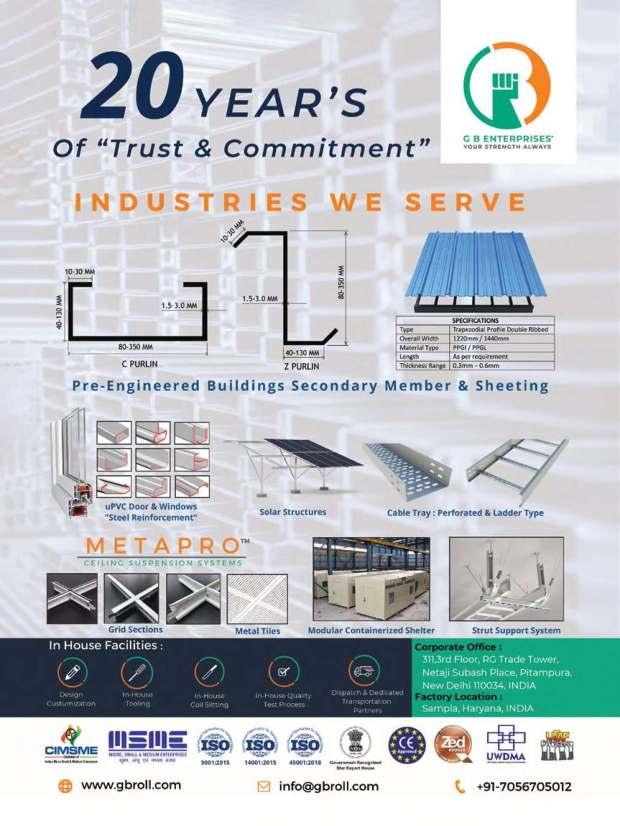


shankesh.rathore@gmail.com













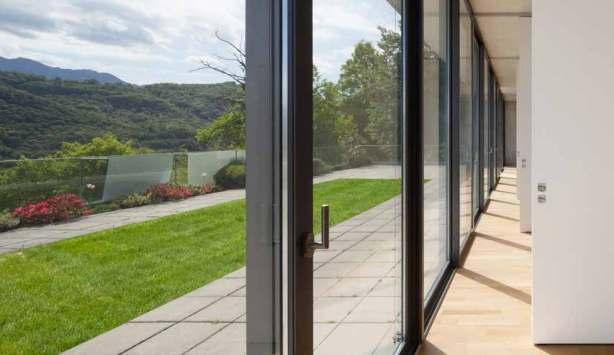



Head Office cum Application Centre: 28/01/8, Site IV, Sahibabad Industrial Area, Ghaziabad (UP) - 201005
Delhi Office: 4899 Hauz Qazi, Delhi-110006


For Sales:
West: 8929070625/9311600436
North: 8929070621/9999697732






Coimbatore Office: 2/227 D Erangathu Thottam, Rasipalayam Sulur, Coimbatore-641402
East: 9319623434
Karnataka: 9999697660
Tamil Nadu & Kerela: 8929070623
Andhra & Secunderabad: 8929070624
Customer Care: 8929701016
Website: www.pego.in Reach us:










